MILESTONES: GULFSTREAM DELIVERS 300TH G280
EVENTS: NEWS FROM THE PARIS AIR SHOW
SAFETY: JOHN AND MARTHA KING TAKE ON THE 'BIG LIE'
BIZJETS: OTTO'S WINDOWLESS PHANTOM 3500

MILESTONES: GULFSTREAM DELIVERS 300TH G280
EVENTS: NEWS FROM THE PARIS AIR SHOW
SAFETY: JOHN AND MARTHA KING TAKE ON THE 'BIG LIE'
BIZJETS: OTTO'S WINDOWLESS PHANTOM 3500

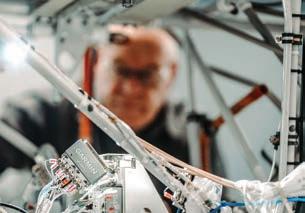
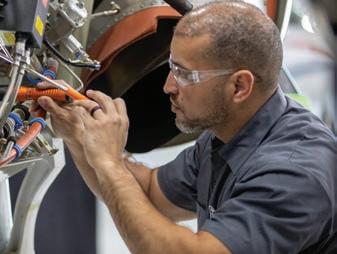
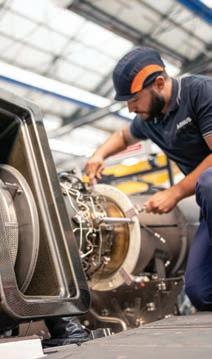



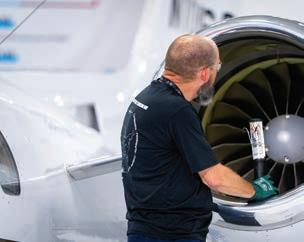
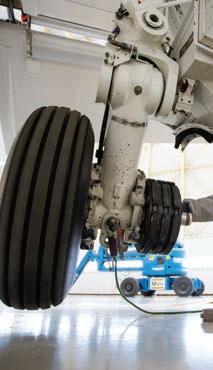





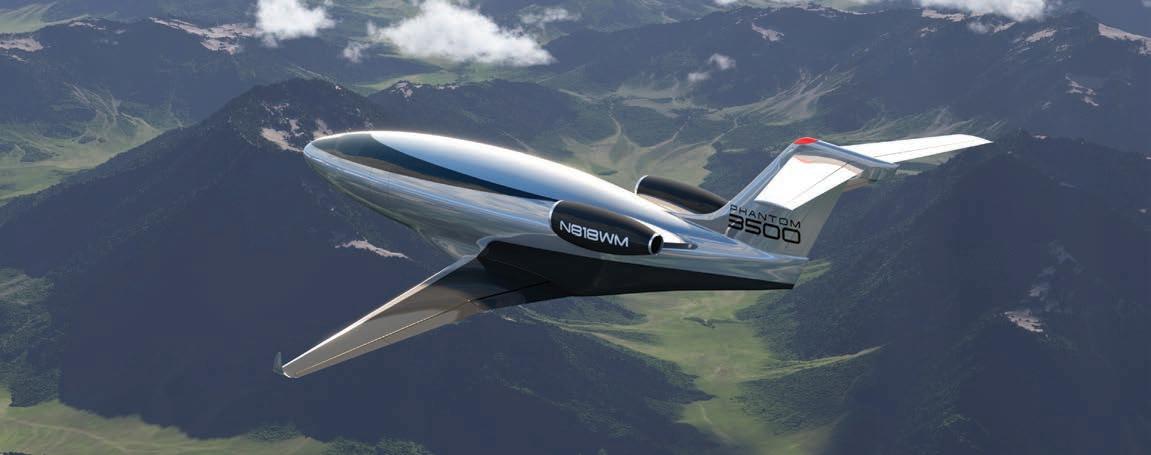
46 Otto’s Phantom bizjet promises midsize performance and comfort
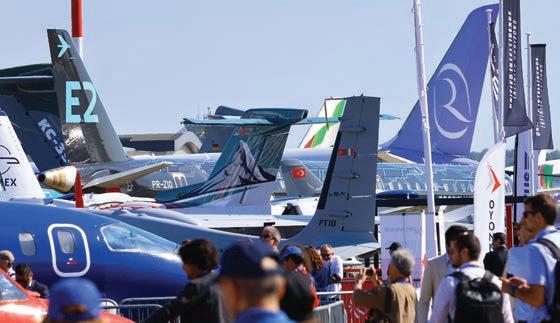
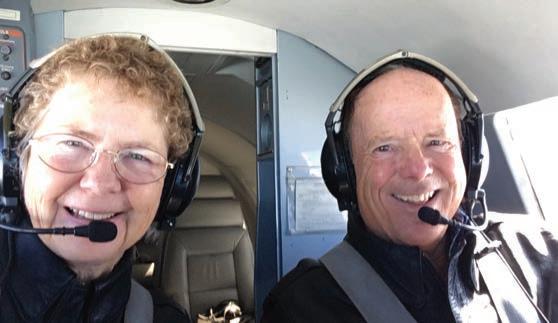
4 Baykar completes Piaggio Aerospace acquisition
6 Dassault Falcon 2000XLS bizjets to be made in India
8 Gulfstream delivers milestone 300th G280
10 Bizav accident fatalities surge in first half of 2025
12 Special Report: AIN Product Support Survey, aircraft OEMs
40 Jet Linx grounds fleet for annual Safety Summit
48 Pilot Report: Flying the Pipistrel Velis Electro
24 Paris Air Show: Tari strife and military conflict vex industry leaders 41 Safety Talk: John and Martha King on how to manage risk DEPARTMENTS 50 Rotorcraft | 52 On the Ground | 54 Accidents |
Compliance | 58 People in Aviation
the cover: AIN Product Support Survey


BY CHARLOTTE BAILEY
Piaggio Aero Industries and Piaggio Aviation have been acquired by Turkish aerospace firm Baykar, with newly granted Italian regulatory approval set to conclude a protracted six-year insolvency restructuring process at Piaggio.
The transfer of Piaggio Aerospace’s business interests to the world’s largest unarmed combat aerial vehicle company represents “a strategic milestone in the relaunch of one of Italy’s historical aerospace brands with a major international investor,” said Italian Minister Adolfo Urso. Finalization of the deal follows approval in June under Italy’s so-called “golden power,” a regulation protecting and regulating transactions that could compromise national strategic assets.
Piaggio Aerospace has been engaged in administrative restructuring since December 2018 following a withdrawal from the previous major shareholder, Abu Dhabi sovereign wealth fund Mubadala. In December 2024, Baykar emerged as the winner of three bidders described by the
Italian Ministry of Business as “the most suitable to guarantee the interests…and relaunch the [Piaggio] Group’s industrial prospects.” Having already extended the deadline for the extraordinary administration’s conclusion twice, the Italian government welcomed Baykar’s expression of intent that it believes would safeguard Piaggio’s “long-term production perspective.”
Throughout the restructuring, Piaggio has continued both airframer and MRO roles—including developing the upgraded P.180 Avanti Evo turboprop twin—business areas that Baykar intends to expand and enhance. Planned workforce expansion could also focus on what Urso identified as “even greater market prospects in the unmanned aircraft sector.”
Although Baykar has yet to build a crewed aircraft, it could also potentially be looking to revive Piaggio’s P.1HH HammerHead medium-altitude long-endurance uncrewed aerial system, which uses the Avanti as its platform. z
An undisclosed customer signed an agreement with Bombardier on June 30 for up to 120 aircraft valued at up to $4 billion. It includes a $1.7 billion firm order for 50 Challenger and Global jets and a product support package, along with options for another 70 aircraft. According to the Canadian manufacturer, deliveries of the firm orders are due to begin in 2027. The customer wishes to remain anonymous as it prepares to announce what Bombardier said will be a new service o ering.
Embraer’s executive jets division continues to ramp up its manufacturing tempo with a 36% year-over-year increase in aircraft production during the first half of 2025. The Brazilian airframer handed over 61 business jets in the first six months, 16 more than during the same span a year ago. For the year, the manufacturer is forecasting 145 to 155 business jet deliveries. In the midsize business jet segment, it saw a 46% increase in deliveries, handing over 15 Praetor 600s and eleven 500s, compared with eight and six, respectively, in the first half of 2024.
Cirrus Aircraft is investing $13 million to expand its Grand Forks, North Dakota manufacturing facility by 30,000 sq ft, bringing the total footprint to 195,000 sq ft. The expansion supports continued production of the company’s SR-series piston single and SF50 Vision Jet models. Construction is scheduled to be completed in second-quarter 2026. The facility enhancement will incorporate additional equipment, storage capacity, and technical tools to support manufacturing operations.
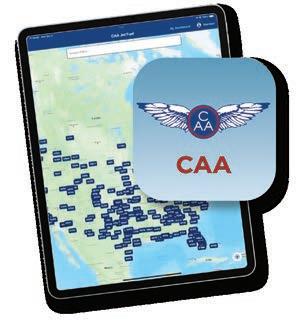

BY CHAD TRAUTVETTER
Falcon business jets will be manufactured outside France for the first time ever under a partnership between Dassault Aviation and Indian company Reliance Aerostructure. Announced at the Paris Air Show, the joint venture—Dassault Reliance Aerospace Ltd. (DRAL)—will assemble Falcon 2000LXS twinjets in Mihar.
Falcon 2000 fuselage and wing assembly will transfer to the Northern India plant, and plans call for the first “Made in India” business jet to roll off the line by 2028.
According to Dassault, the partnership “represents a significant step in advancing India’s aerospace manufacturing capabilities while strategically integrating into the global aviation supply chain.”
DRAL has manufactured Falcon 2000 nose sections since 2019 and has assembled more than 100 major subsections for this model. The DRAL facility will be designated as a center of excellence for Falcon business jets, including the Falcon 6X and 8X programs. This marks Dassault Falcon’s first center of excellence outside France.
“This new agreement…illustrates, once again, our firm intent to meet our ‘Make in India’ commitments and to contribute to the recognition of India as a major partner in the global aerospace supply chain,” said Dassault Aviation chairman and CEO Éric Trappier. “It marks the ramp-up of DRAL, in line with the strategic vision shared with our partner Reliance, which led to its creation in 2017 and is a testament to our unwavering belief in our future in India and serving India.”
Reliance Group founding chairman Anil Ambani added, “Our partnership with Dassault Aviation for manufacturing of Falcon business jets in India is a defining moment for the country, aviation industry, and the Reliance Group. This will help position India as a key force in the global aerospace value chain.”
The joint venture aims to recruit several hundred engineers and technicians over the next decade to support expanding operations in Mihar. “This growth underscores Dassault Aviation’s deep commitment to strengthening India’s aerospace manufacturing ecosystem and advancing the nation’s emergence as a global center of excellence for high-precision aviation production,” the French company said. z
Passage of the budget reconciliation bill last month cleared the way for ramped-up spending on U.S. air tra c control modernization, return of full bonus depreciation, and increased research and development expensing. Congress settled on a $12.52 billion package to upgrade, reorganize, and add air tra c control facilities. The bill also permits expensing 100% of qualified business property purchases, including new and preowned business aircraft, e ective Jan. 20, 2025, as well as research and development costs. It also provides an extension of the Section 45Z Clean Fuel Production Credit that incentivizes production of sustainable aviation fuel.
Business aviation operators swung into action to deliver critical supplies to those a ected in Kerr County and the Guadalupe River area following the devastating flooding in Texas on July 4 that killed more than 100 people. Leading the e ort, Operation Airdrop established supply bases at the Commemorative Air Force Museum at Burnet Municipal Airport (KBMQ) near Kerrville and the Million Air FBO at Dallasarea Addison Airport (KADS) to accept donations. Airlink, another aviation charity, transported volunteers to help fill the urgent need for rescue, recovery, and cleanup.
Former Republic Airways president and CEO Bryan Bedford became the FAA administrator after the U.S. Senate voted 53 to 43 on July 9 to confirm his appointment as agency chief for a five-year term. Bedford led Republic Airlines since July 1999 as president and CEO after serving in the same roles at Mesaba Holdings and Business Express Airlines.
The most innovative feet in Gulfstream history, with expert customer support anytime, anywhere.


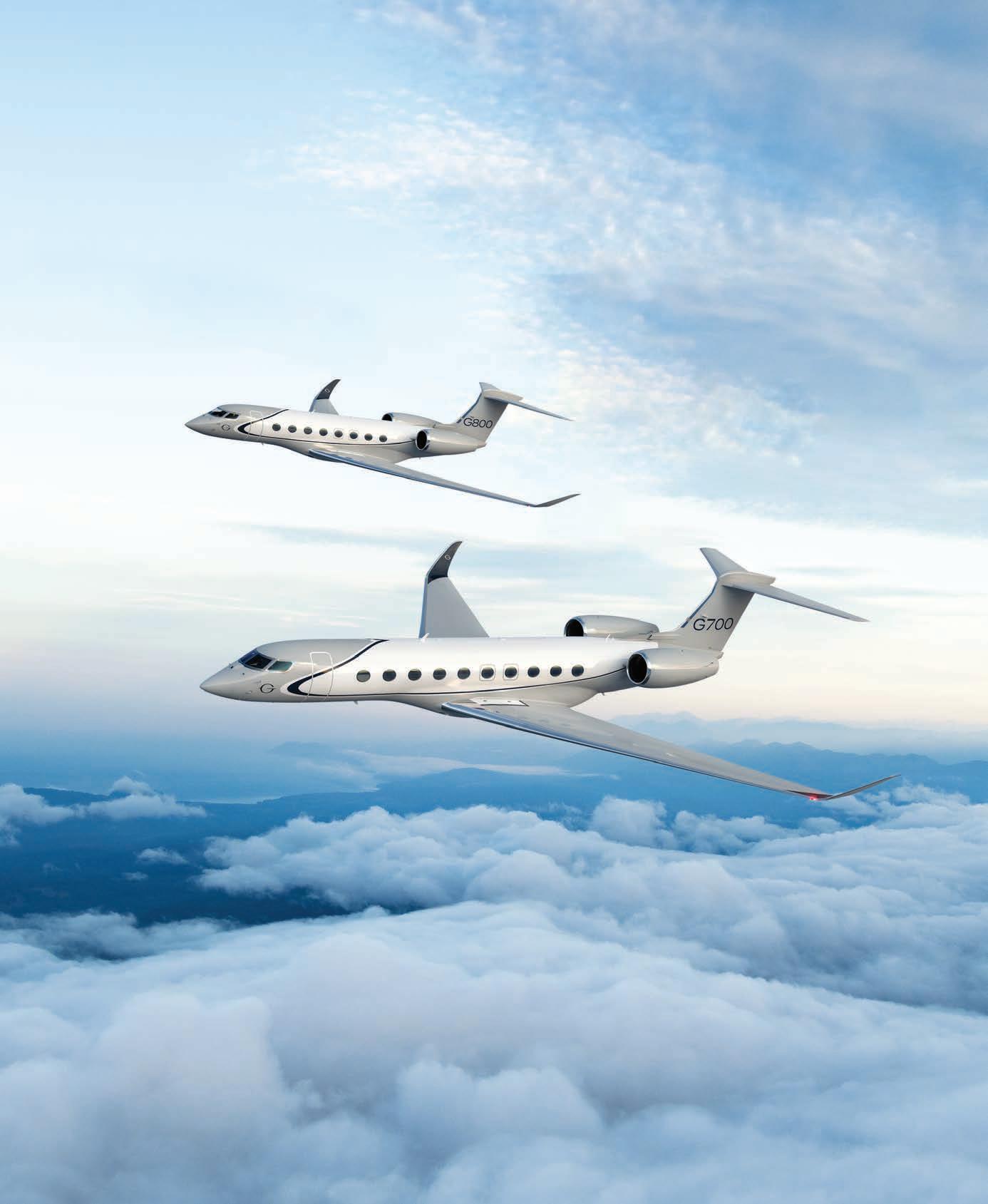
BY CURT EPSTEIN
Gulfstream has delivered its 300th super-midsize G280. The company handed over its first of the twinjets in 2012, and its in-service fleet has tallied more than 575,000 flight hours and nearly 358,000 landings since.
The type—the smallest in Gulfstream’s product range—has earned a dispatch reliability rate of 99.98% and has achieved 87 city-pair speed records. With multiple seating options, the G280 can carry up to 10 passengers. Its Honeywell HTF7250G engines give it a range of 3,600 nm at a long-range cruise speed of Mach 0.80.
Gulfstream continues to invest in the G280 platform, developing new features that enhance passenger comfort and increase safety while improving crew efficiency. The jet is also certified to the FAA’s stringent Stage 5 noise standards.
The milestone G280 was delivered from the General Dynamics subsidiary’s
completions facility in the Dallas-Fort Worth area.
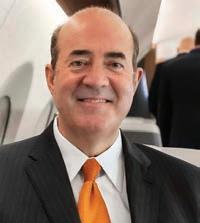
“Achieving this delivery milestone reinforces the continued strong demand for the G280,” said Mark Burns, the Savannahbased airframer’s president. “Known for its unique combination of speed, performance, and cabin flexibility, the G280 remains top of the super-midsize class and continues to set the industry standard.” z

Daher Aircraft marked a major production milestone at the recent Paris Air Show with the delivery of the 600th aircraft in its TBM 900 series. The milestone aircraft, a TBM 960, was handed over to U.S. buyer Jim Baum on June 19 at Daher’s static display at Le Bourget Airport. Baum is a repeat customer who previously owned a TBM 930 and a TBM 940. His TBM 960 includes a full suite of TBM e-copilot functions, including Garmin Autoland.
Procedural failures, or human factors, were the biggest element at work in business aircraft safety incidents and accidents last year, according to Nimbl’s Safety Report for business aviation. The report lists 16 incidents and 96 accidents among business turboprops and jets in 2024, compared with 13 incidents and 108 accidents in 2023. Recommendations in the report include enhanced checklist discipline, recurring facility audits, more robust document management, and improved preflight planning for fatigue and rerouting.
Holger Krahmer abruptly stepped down from his role as secretary general of EBAA on June 27, following the resignation in May of COO Robert Baltus, who will take a new role at Dutch King Air operator Zeusch Aviation this month. EBAA called the departures “a series of leadership changes as part of a broader organizational reform initiative aimed at enhancing the association’s e ectiveness, responsiveness, and value.” Former Jet Aviation and Luxaviation executive Stefan Benz was appointed as EBAA interim managing director. EBAA also delayed its announcement—originally expected June 30—about where its annual EBACE show will be held next year.





BY GORDON GILBERT
In the first half of this year, 18 fatal turbine business aircraft accidents worldwide claimed the lives of 81 passengers and crew, compared with 17 fatal accidents and 54 fatalities in the first six months of 2024. According to preliminary data gathered by AIN, as a group, U.S.-registered business
jets made up the only segment to complete the first six months of this year with fewer fatalities than in the same period in 2024. Nine people lost their lives in three U.S.-registered business jet accidents last year, versus eight people who died—also in three accidents—this year.
Flexjet and Ferretti Group have unveiled Riva Volare, a custom interior concept for the Gulfstream G650 and Sikorsky S-76 that draws inspiration from Riva motoryachts. “Riva style is an expression of elegance that infuses every project with class and exclusivity,” said Ferretti Group CEO Alberto Galassi. “Contemplating the sky and the clouds while immersed in the world of Riva is an incredibly beautiful and satisfying experience.” The interiors are featured on a Flexjet G650 and two of its S-76s based in Florida and Milan.
Bombardier has opened an innovation and design center in Montreal, a strategic facility focused on advancing the cabin experience for business aviation customers. The space will house full-scale mockups and prototypes, allowing Bombardier teams to experiment, iterate, and validate concepts. Located near Bombardier’s manufacturing facilities in the Montreal area, the center aims to allow seamless collaboration between industrial designers, engineers, and upholsterers.
The FAA has transferred responsibility for reviewing foreign instrument procedures to operators with guidelines in a new advisory circular and revised authorizations a ecting Part 91K, 121, 125, and 135 operations. Principal inspectors must contact operators by September 3 to initiate the reissuance process. The FAA will remove foreign procedures and airports from OpSpec/MSpec/ LOA templates C059, C060, and C384, and decommission C058, C358, and H107. Going forward, operators must evaluate the procedures themselves in accordance with Advisory Circular AC 120-105B.

BY CURT EPSTEIN

After its rise from the bottom of the business jet manufacturer ratings to the top spot last year in AIN ’s annual Product Support Survey, Bombardier retained that position for a second year in a row, despite changes to the AIN survey methodology that weighted more toward independent reviews. The Canadian OEM scored the highest in three of the 10 survey categories (cost per hour programs, parts availability, and AOG response) to receive an overall average score of 8.14 from respondents.
That total narrowly edged out Gulfstream—which led in factory owned service centers and technical representatives— and Embraer, which was tops in cost of parts, technical manuals, warranty fulfillment, and overall aircraft reliability. In the business jet ratings, they were followed by Dassault and Textron Aviation, the latter earned top score in the authorized service center category.
On the turboprop side, Daher—a newcomer to the AIN Product Support Survey’s reported ratings—took over the top spot this year, not just for turboprops, but for all OEMs with an overall average score of 8.78.
In the rotorcraft segment, only Leonardo tallied enough responses to have its scores validated in this year’s survey.
As for the issues faced by the OEMs, labor in their service networks is a major one.
“The helicopter maintenance industry continues to grapple with an aging workforce and a lack of young technicians entering the field,” said Francesco Bellardi, v-p of Leonardo Helicopters customer support and services Italy. “However, there’s a strong focus on improving recruitment pipelines, offering accredited continuous training at our academies, mentorship programs, and enhancing employer reputation
to both attract and retain key talents, also considering that new skills are requested, for example in data analytics.”
Bombardier has hired more than 100 maintenance apprentices as it works to develop its future workforce. The manufacturer is recruiting hundreds of technicians across its global network and is also establishing an incubator training center at its Wichita location.
For years, Daher has partnered with the General Aviation Manufacturers Association on an internship program, which brings students from North America and France to its production and final assembly sites, with the finale taking them to work with the company’s team at the annual Experimental Aircraft Association AirVenture show.
Dassault reported it has been especially successful in its efforts to staff its new service location in Melbourne, Florida.
AIN ’s annual Product Support Survey aims to quantify and rate through statistical analysis the product support functions of aircraft manufacturers over the past year. The survey, whose respondents include operators of business jets, pressurized turboprops, and turbine-powered helicopters, endeavors to encourage continuous improvement in aircraft product support throughout the industry.
For the fourth year, AIN conducted the survey via a questionnaire developed in partnership with Rolland Vincent Associates, a Texas-based consultancy focused on aviation market research, strategy, and forecasting. Designed to provide improved ease of use and to encourage more participants to complete the entire questionnaire, the English-language survey tool includes clear language and imagery around the categories and evaluation scale. The survey
asks respondents to evaluate one full aircraft at a time, including airframe, engines, avionics, and cabin management systems.
AIN emailed qualified readers from its list of subscribers a link to the password-protected survey website active from late February to June 1, 2025. It asked respondents to rate individual aircraft and provide the tail number, aircraft age, primary region of service, and whether they used factory- owned or authorized service centers, or both. The survey also asked respondents to rate, on a scale from 1 to 10, the quality of service they received during the previous 12 months in the following categories: Factory Owned Service Centers; Authorized Service Centers; Cost Per Hour Program; Parts Availability; Cost of Parts; AOG Response; Warranty Fulfillment; Technical Manuals; Technical Reps; and Overall Aircraft Reliability. In order to boost the total number of responses
and broaden the global reach of the Product Support Survey, AIN’s e-mail recruiting e orts were supplemented by manufacturer (OEM) outreaches. Tabulated results represent a supermajority of AIN-recruited responses, with the goal of maintaining the primacy of AIN ’s survey recruiting and minimizing the potential for sampling bias.
In total, 948 unique respondents representing 1,863 aircraft from 62 countries completed the survey. While total responses were higher than last year’s total, AIN did not receive enough ratings to verifiably report results for Cirrus Aircraft, Honda Aircraft, Piper Aircraft, Airbus Helicopters, Bell Textron, and Robinson Helicopters, amongst the larger OEMs. Rolland Vincent Associates reviewed and analyzed the data to ensure accuracy, validity, and sampling integrity.
Retaining its position at the top of this year’s AIN Product Support Survey among business jet makers, Bombardier earned its highest score in the technical representative category with an 8.82. “We’ve been focused for the last couple of years on making sure that we leveraged our relationship of a family-owned business with our customers,” said Anthony Cox, Bombardier’s v-p of customer support. “That really comes down to giving the customers confidence, and that confidence is borne from us committing to certain regions.”
To service its fleet of nearly 5,300 in-service private jets, the Montreal-based airframer has concentrated on augmenting its company-owned facilities around the world, from starting construction of a 120,000-sq-ft maintenance center in Abu Dhabi, UAE, slated to be operational in late 2026; to establishing line service stations in Sydney and Perth, Australia; to expanding its location at Paris–Le Bourget Airport; to adding a two-bay paint facility in Singapore.
In the U.S., the airframer has enhanced its AOG maintenance infrastructure with 11 new technicians at Teterboro alone and 32 mobile repair trucks across the country. It added Atlanta to its network and expanded its presence in Columbus, Ohio. The company now has a dedicated engine mobile response team of technicians, allowing it to service customer aircraft engines directly, rather than relying on third-party maintenance providers. That investment has paid off, with the Canadian firm leading the AOG response among the major jet manufacturers with an 8.41 score.
To build capacity, the company has added more than 500 technicians to its maintenance staff worldwide over the past year, according to Cox, including 20 at its U.S. flagship location in Wichita. “Typically, we have well in excess of 300 aircraft in the network under work every day,” he told AIN, adding that a new peak of 322 was set earlier this year.
In Wichita, the OEM is expanding its component repair and overhaul capabilities to meet increasing demand and reduce turn times. Bombardier’s recently expanded tire and wheel shop serviced 4,200 tires last year. That capacity has now increased to 20,000 annually.
Bombardier has sharpened its focus on service in several areas, including AOG support. The company’s target for AOG return to service is 24 hours or less, and to accomplish this, Bombardier has parts stockpiled in various regions, giving it a 92% “off the shelf” shipping rate.
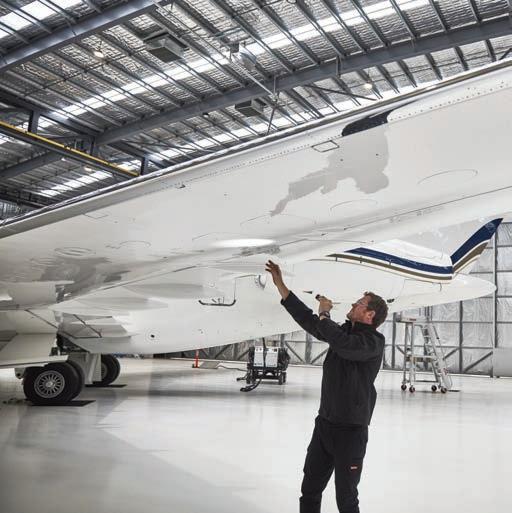
Over the past year, as part of growth in aftermarket services and support, it shipped nearly 200,000 line-item parts through its hubs in Chicago, Frankfurt, and Singapore, and in smaller depots, fueling a 40% year-over-year increase in parts requirements every week. The airframer has invested $100 million in additional inventory, and as a result, “We’re seeing the customer satisfaction tied to parts transactions has been improving year on year,” said Cox. While parts availability was a low point in most of the business jet OEM ratings this year, Bombardier led the category with a 7.61 score.
Another initiative is the OEM’s Smart Link Plus aircraft health monitoring system, which was initially developed for the Global 7500 to collect digital data. A subscription service, Bombardier has expanded it through retrofit to cover the Global 5500 and 6500, as well as the Challenger 3500 and 650. It now has nearly 400 aircraft enrolled. The platform measures up to 20,000 parameters per millisecond, and a beta test is underway to use that data to drive predictive maintenance via artificial intelligence.
For face-to-face interaction, the manufacturer conducts two customer advisory conferences a year for the Global, Challenger, and Learjet platforms. For Challengers, it recently held its 101st such event, while for the Globals and Learjets, it has surpassed 50 and 66, respectively, over the past year.
Gulfstream continues to expand its customer support network to meet the needs of its growing fleet and subsequent demand. It recently established a new executive position, promoting Derek Zimmerman from president of its customer support operation division to oversee the OEM’s entire enterprise supply chain operations, including procurement, logistics, inventory, repair and overhaul, distribution, and spare parts.
Its factory-owned service centers earned the highest score among business jet manufacturers this year with an 8.08. At its Savannah/Hilton Head International Airport (KSAV) headquarters, the company last year improved its service capabilities with the opening of an additional 137,000-sq-ft maintenance facility: Savannah Service Center East. The $150 million structure complements the company’s main service center at KSAV by adding more hangar space, offices, and back shops. This additional capacity brings its total service footprint at the airport to 1.1 million sq ft and allows Gulfstream to simultaneously accommodate up to 85 aircraft there, 26 more than it previously could handle.
In January, the airframer officially opened its $130 million service center expansion at Arizona’s Mesa Gateway Airport (KIWA). Its existing facility—known as the Mesa West campus—can accommodate up to 10 large and midsize aircraft, while the newly-opened service center on the other side of the field builds on that capacity to handle up to 13 more largecabin jets simultaneously with the ability to support maintenance and avionics services, inspections, and drop-in work.
“We also grew our footprint of authorized warranty facilities [AWF], by adding more locations to our network,” said Lor Izzard, the General Dynamics subsidiary’s senior v-p for customer support. “We have aircraft based around the world, and these AWFs offer convenient access to warranty service, maintenance, and parts for our customers.”
The new AWF partners were selected based on customer
feedback and fleet needs. In addition to the authorized service centers from sister company Jet Aviation, Gulfstream now has 27 AWFs around the world, which earned a score of 8.65 in the authorized service center category from AIN’s readers in this year’s survey.
With all of the expansion, Gulfstream has increased its service staff to more than 5,500 members, equating to more than 25% of the company’s workforce worldwide. The OEM shone in this area, with its technical representatives earning an 8.96—the highest score among business jet manufacturers in this year’s survey. Over the past year, Gulfstream has expanded its Field and Airborne Support Teams by 40% in response to customer feedback. That group received an 8.40 in the AOG response category.
Extensive training of its service staff preceded the entry-into-service of the G700 last year and more recently its G800, which received approval in April.
In terms of parts, to ensure the right items and quantities are available, the airframer has invested more than $2 billion in inventory across its global network. It now has 12 spares distribution locations globally. However, in the minds of this year’s survey respondents, it was the cost of those parts that gave the airframer the lowest score in the category (6.06) among the major private jet manufacturers.
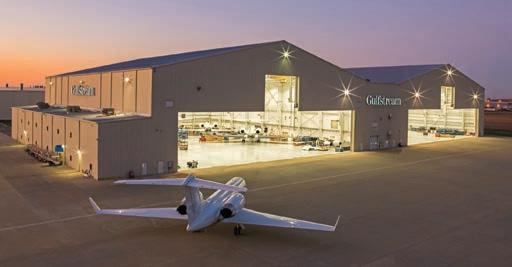
With its fleet claiming the top spot in the aircraft reliability category with a score of 8.98 in this year’s survey, Embraer Executive Jets is continuing to expand its MRO footprint.
Last year, the OEM doubled its maintenance network in the U.S. to six facilities with the opening of three new factory-owned service centers—at Dallas Love Field
(KDAL), Orlando Sanford (Florida) International Airport (KSFB), and Cleveland-Hopkins (Ohio) International Airport (KCLE).
In June, Embraer—which earned top honors this year among business jet manufacturers with an 8.79 in the warranty fulfillment category—added a new four-bay, 18,000sq-ft hangar at its facility in Fort Lauderdale, Florida (KFLL), which will eventually account for 50,000 maintenance hours a year. Meanwhile, at its locations in Melbourne, Florida (KMLB), and Mesa, Arizona (KIWA), it has added maintenance shifts.
To improve its AOG response, the manufacturer has increased the number of mobile repair trucks in the U.S. to 40. In its home country, it recently doubled the facilities at its Sorocaba service center.
The Brazil-based airframer’s service network now includes eight Embraer-owned service centers and 44 authorized third-party service centers across the Americas. It has 74 repair centers worldwide, with the latest additions being Gama Aviation in the UK; Jet Access in Gallatin, Tennessee; Jet Center in Naples, Florida; and ExecuJet MRO Services Australia’s facility in Perth.
Overall, it has worked to improve its customer interactions. “We’ve streamlined key touchpoints such as parts ordering, maintenance quoting, and MRO capabilities,” said Marsha Woelber, v-p of worldwide customer support and sales, “while optimizing inventory and availability to ensure faster, safer returns to service with better communication and quality.” As part of that commitment, the OEM’s technical manuals received the highest score (8.74) among the major business jet airframers in this year’s survey.
Woelber noted that Executive Care, Embraer’s airframe
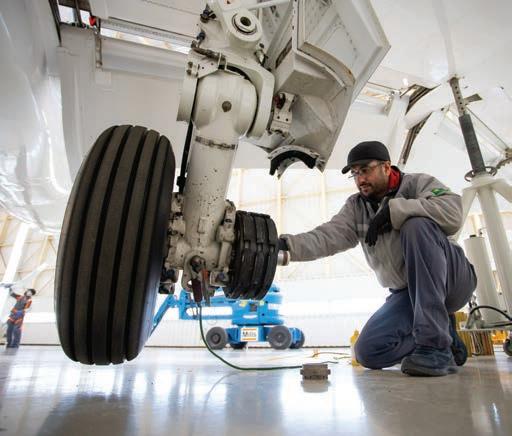
maintenance program, continues to evolve with its components regularly reviewed to ensure that the program remains aligned with its customers’ operations and support needs. With a score of 7.61, it placed firmly in the middle of the cost-per-hour programs category.
In terms of the supply chain, the company noted the situation is improving “day by day,” but it is still encountering some challenges as indicated by this year’s survey. In the parts availability category, it received the lowest score this year among the major business jet manufacturers, with a 6.67. Yet conversely, for those available parts, it was ranked most favorably among all manufacturers for cost of parts with a 7.27. Like most OEMs, it is working with its suppliers to mitigate risks, in some cases even embedding employees in supplier facilities to help anticipate and navigate any possible delays.
“Dassault is constantly broadening and strengthening its global MRO footprint,” explained Jean Kayanakis, senior v-p of the airframer’s customer service and service center network. “It continues to invest in new and modernized facilities with well-qualified teams.”
In this year’s AIN product support survey, the French OEM received a 7.95 overall average score, just off the pace set by the
leaders, while its Falcon aircraft earned an 8.43 reliability score. Last year, it opened a nearly 40,000-sq-ft (3,600-sq-m) service center in Brazil at São Paulo Catarina International Executive Airport (SBJH). The facility can accommodate up to five Falcons simultaneously and is spacious enough to handle the 10X, which will be the largest business aircraft in Dassault’s lineup when it enters service in 2027.
In late 2023, the French airframer broke ground on a $100 million, 175,000-sq-ft Falcon service center at Florida’s Melbourne Orlando International Airport (KMLB), which it expects will open “imminently.” The facility will simultaneously accommodate up to 18 Falcons and will include a 54,000sq-ft paint shop, as well as serve as a regional Falcon parts distribution hub.
Last year, Dassault’s large-cabin, long-range 6X entered service, and with deliveries of it to North America, Europe, the Middle East, Africa, and India, 20 service centers in its network have been authorized to support them. The fleet thus far has racked up several thousand hours of operations, and those first aircraft are undergoing their initial 12-month inspections. “The FalconScan diagnostic system is proving its worth in maintenance monitoring and troubleshooting,” Kayanakis told AIN
The OEM is leveraging new technology in other ways, including 3D illustrated parts catalogs, improvements to its online services (such as its parts marketplace), and a customer service portal.
Dassault’s technical representatives earned its highest category score this year with an 8.84, and according to Kayanakis, the focus this year has been on expanding AOG

support. In the U.S., it has mobile repair teams stationed at strategic locations around the country—at the biggest business aviation hubs of Teterboro Airport in New Jersey and Los Angeles-area Van Nuys Airport—as well as Stuart, Florida, and Denver, with 20 technicians dedicated solely to AOG response. “Elsewhere in the world, we assemble teams from MROs, and this system is working well, reducing time to return aircraft to service,” said Kayanakis.
Over the past year, Dassault’s Falcon spare parts inventory topped $1 billion for the first time.
Textron Aviation’s business jet fleet, which includes the Cessna, Hawker, and Beechcraft lines, scored 7.70 overall in this year’s AIN Product Support Survey. Excluding the King Air family (support of which is addressed on page 20), the company’s aircraft received an 8.69 overall reliability rating.

To better serve its global customer base, Textron has focused on enhancing its spare parts availability, which received a score of 6.89 in this latest survey. Last year, it celebrated the grand opening of the expanded North American parts distribution center at its Wichita, Kansas headquarters. The airframer added 180,000 sq ft of space, with that larger footprint allowing for increased parts inventory investment, supporting both new and existing aircraft models.
Following its recent increase in parts inventory in Alaska, the company relocated its stockroom from Fairbanks to Anchorage to improve the distribution of parts there for all Cessna and Beechcraft operators.
For all of its spare parts, Textron has doubled its warranty period from six to twelve months, and last year enhanced its e-commerce website to make it easier for users to obtain them. A “shop-by-model” search feature was introduced to speed browsing for specific parts. For large parts, customers
will now receive a notification at checkout when their selected shipping method requires oversized options.
The OEM also highlighted its service improvements in Australia. It rebranded Premiair Aviation Services—the Australian MRO chain it acquired in 2020—to Textron Aviation Australia to fully integrate its locations in Perth, Melbourne, and the Gold Coast into its global service network.
At Essendon Fields Airport in Melbourne, the OEM began construction in March on a larger, modern facility that is slated to open early next year. It also expanded its parts storage facility there by 5,000 sq ft, quadrupling its spares inventory in the region. Textron Aviation further added a new customer support and warranty center in Melbourne to support all Cessna, Beechcraft, and Hawker parts needs for the more than 1,400 of its aircraft operating in the region.
In Perth, it relocated its Jandakot Airport operation to a larger facility on the field, providing increased space for servicing aircraft and improving scheduling to lessen customer aircraft downtime.
In Germany, the Wichita-based manufacturer renovated
its service center at Düsseldorf Airport with a new customer lounge, larger briefing room, and LED lighting throughout.
While the company’s factory-owned service centers received a score of 7.82 from AIN’s readers this year, Textron’s authorized service network led all manufacturers with an 8.82 rating.
To tap the potential of digital information, Textron worked with Microsoft to introduce its proprietary Textron Aviation Maintenance Intelligence, an artificial intelligence assistant for aircraft technicians. Covering 60,000 pages of aircraft maintenance documentation, it provides Textron’s 1,600 service technicians at its 20 global service centers with immediate access to information and tools to minimize the time its aircraft spend under maintenance.
The service network also developed the Data Optimized Task Sequencing (DOTS) process, which leverages data gathered from decades of maintenance. According to the company, DOTS helps identify potential discrepancies earlier in inspections and provides its technicians with a step-by-step sequence for inspecting Citations and King Airs based on thousands of previous inspections, driving faster maintenance velocity.
Honda Aircraft had insufficient responses to post a valid sample of scores.
A focus for Honda Aircraft’s product support efforts has been increasing the availability of its customers’ aircraft. The manufacturer’s revision of the HondaJet airworthiness limitation and inspection manual has reduced downtime during the 600-hour inspection. Revision J, according to the company, “supports greater aircraft availability for customers and improves the overall HondaJet operator experience.”
Maintenance processes are more efficient with a major update to the HondaJet illustrated parts catalog, which is now published as a 3D interactive manual. This enables technicians to view “digital models of parts and aircraft assemblies that facilitate HondaJet maintenance and help reduce maintenance manhours,” according to Honda Aircraft.

To enhance cabin comfort, HondaJet owners have some new optional service bulletins that add swivel seats and custom carpet choices.
Supply-chain issues remain problematic, and Honda Aircraft specialists are working with suppliers to ensure a steady flow of materials needed for HondaJet manufacturing. “Without getting into specifics,” the company said, “complex supply chains
in advanced manufacturing can be impacted by difficulties at sub-tier suppliers, which ultimately then affect the availability of the parts we purchase for final assembly of the aircraft.”
Like many aircraft manufacturers, Honda Aircraft has partnered with local educational institutions to ensure a steady flow of workers. “Honda Aircraft has found a community
Having tallied enough responses to be listed in the AIN Product Support Survey, Daher debuted at the top of all airframers this year with an overall score of 8.78. Its mark of 9.65 in aircraft reliability was the highest score in any of this year’s survey categories, and it led the turboprop segment in parts availability (8.06), cost of parts (6.80), AOG response (9.05), technical manuals (9.28), and technical representatives (9.55).
Over the past year, the France-based airframer has greatly expanded the cloud-based applications for its aircraft owners/ operators. Initially launched in 2018, the company released the seventh iteration of its Me & My TBM app last October at NBAA-BACE. It is used by more than 400 active users each month, recording data from an average of 80 flights a day.
One of its latest enhancements is its merger with the OEM’s My TBM Docs app, which incorporates publications such as pilot information manuals and maintenance manuals, enabling streamlined, real-time document management and enhanced usability via mobile devices.
At EAA AirVenture, Daher introduced the Me and My Kodiak app, which features the same automatic flight data collection functions for its rugged utility airplane. Users can check the status of their aircraft anytime from anywhere, and can connect to their Garmin account to update the database status and locate the aircraft’s position.
Both systems leverage Daher’s big data expertise to collect and process millions of data points a day for use in detecting anomalies, analyzing root causes, and generating diagnostics, resulting in faster repairs, less downtime, and safer flights.
To provide its customers with the knowledge and tools to maintain and operate their aircraft at the highest levels of safety, Daher has introduced the Safe Horizons program, which focuses the resources it provides to the TBM
receptive to its recruiting efforts in North Carolina and across the country. North Carolina is home to a strong network of educational institutions with which Honda Aircraft has partnered to help cultivate the next generation of aviation talent. Honda makes a good effort to treat its employees well, and we see that reciprocated in strong employee retention.”

and Kodiak users, including its E-Learning program and the above-mentioned apps. It also leverages the company’s long-standing collaboration with the TBM Owners and Pilots Association, reinforcing their joint focus on operational safety as the priority.
The airframer has four company-owned service centers: Pompano Beach, Florida; Sandpoint, Idaho (home of the Kodiak production facility); and in France at Tarbes (home of the TBM assembly line); and the Paris-area Toussus-le-Noble Airport. They are supported by a network of 68 authorized service centers worldwide, some of which are approved for both of Daher’s product lines, while others focus on TBMs or, in the case of the latest—Silver Sky Aviation in Alaska—just Kodiaks. The airframer is introducing strict guidelines in the form of an authorized service center contract and authorized service policy manual to detail areas such as service facility policies, logistics, service engineering, and warranty and maintenance program guidelines.
Swiss airframer Pilatus is known for its popular turboprop single PC-12 as well as a growing fleet of PC-24 light jets. The company received an 8.08 overall score from the AIN Product Support Survey respondents this year.
Having delivered more than 2,700 PC-12s, along with nearly 300 PC-24s (which did not receive enough operator ratings to have scores included in this year’s survey), Pilatus’ aircraft fleet has tallied more than 12 million flight hours. It expects to begin deliveries of its recently-certified PC-12 PRO by the end of the year.
The PC-12 was recently identified as the most frequently flown business aircraft in the U.S., with 316,328 takeoffs between August 2023 and July 2024, and in the overall aircraft reliability category, it earned a 9.21 from AIN’s readers.
At Pilatus’ headquarters in Stans, Switzerland, a warehouse expansion will nearly double the building’s parts storage. The company also acquired a new warehouse facility, dedicated to customer support, 5 kilometers away.
In 2022, the company bought U.S. aircraft maintenance provider and dealer Skytech, which it continues to operate as an independent company with responsibility for servicing and sales of PC-12s and PC-24s on the East Coast, in addition to aircraft types from other manufacturers. Pilatus recently acquired Aero Center Epps’ Pilatus sales and maintenance operations at Atlanta DeKalb–Peachtree Airport to give it three locations under the Skytech brand.
It also named three new authorized service centers in the Americas: Pro Star in Grand Rapids, Michigan; Banyan Air Service in Fort Lauderdale, Florida; and Indaer-Hessa in Buenos Aires, Argentina.
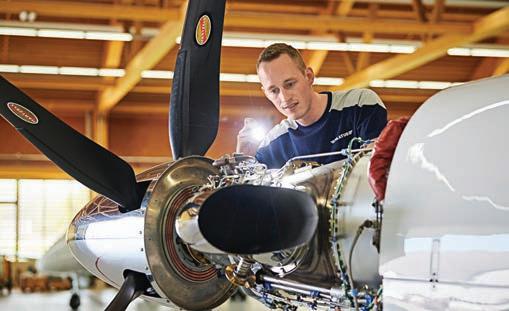
To keep in touch with its customer base, the OEM held five operator conferences around the world last year and launched a new and refreshed website, which enables customers to quickly find the right service center. It also offers clearer support options and streamlined contact features, helping operators get assistance faster.
“We’ve made significant strides in strengthening our global support network and enhancing the ownership experience for our customers,” Piotr Wolak, the Swiss airframer’s v-p of customer service, told AIN. “From expanding service coverage in key regions and appointing new service centers, to launching our refreshed website and further investment in parts infrastructure in Stans—every step reflects our unwavering commitment to providing responsive, reliable, world-class support. These milestones, alongside the successful launch of the PC-12 PRO and continued delivery of our aircraft, underscore Pilatus’ dedication to customer satisfaction at every stage of the journey.”
Textron’s turboprop division (covering the Beechcraft King Air family) earned its highest score (8.91) in aircraft reliability in this year’s survey. The turboprop unit’s overall score was dragged by it receiving the lowest score in the survey for cost of parts, with a 5.96. Textron’s authorized service centers were rated at 8.68 by AIN ’s readers, half a point higher than the 8.18 score given to the company’s factoryowned service centers.

While Mitsubishi hasn’t built an MU-2 twin turboprop for nearly four decades, there are still more than 220 of them in operation around the world, supported by Mitsubishi Heavy Industries America (MHIA) in Dallas, along with Intercontinental Jet Service—a company-owned factory service center in Tulsa, Oklahoma—and four authorized service centers. The level of support for the long-out-of-production aircraft has not abated over the ensuing decades, with the company earning an impressive 8.63 overall score from AIN’s readers. Its factory-owned service centers received a 9.27, the highest in the category among manufacturers in this year’s survey, while the MU-2 authorized service centers scored
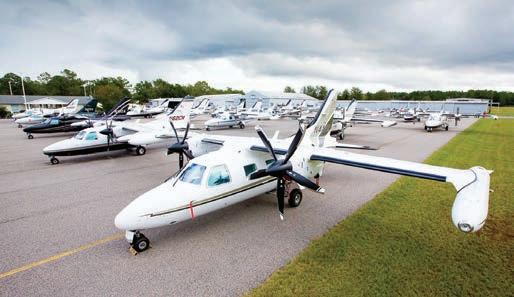
a 9.03, again the highest among the OEMs. In terms of dependability, the veteran turboprop-twin continues to soar, receiving a 9.38 in the aircraft reliability category.
The MU-2 product support program offers genuine OEM spare parts and customer support through engineering, field support, and safety seminars, as well as access to technical publications such as flight manuals, checklists, and maintenance information.
In August, the company relocated its MU-2 product support team to a new office in Coppell, Texas, near Dallas Fort Worth International Airport.
For the first time since before the pandemic, the airframer will this year again be hosting its Pilot’s Review of Proficiency (PROP), a free flight safety seminar for MU-2 pilots. It will cover flight training requirements, best practices, and knowledge-based learning opportunities while highlighting some of the onboard safety enhancement systems specific to the aircraft.
MHIA has renewed its 20-year-plus relationship with flight simulator training provider Simcom in Orlando, Florida. Simcom is in the process of upgrading one of the flight training devices to modernized computers and associated hardware to ensure availability.
Among the rotorcraft manufacturers, only Leonardo Helicopters received enough ratings for its scores to be calculated in this year’s product support survey. The Italy-based manufacturer achieved an overall score of 7.71, led by the quality of its technical representatives, which received a 9.29. In terms of aircraft reliability, AIN’s readers gave it an 8.69.
“Over the past year, Leonardo has implemented several key initiatives to enhance product support for rotorcraft owners and operators,” said Francesco Bellardi, v-p of Leonardo Helicopters’ customer support and services in Italy, adding that it has invested in expanding its support network to ensure closer proximity and better service to customers worldwide.
As an example, it has added new authorized service centers or expanded the capabilities of existing network locations, efforts which garnered a score of 7.94 for the category in this year’s survey. Leonardo’s customer support services and training team comprises more than 2,400 people out of more than 13,000 employees companywide.
Leonardo has also accelerated its digital transformation to provide a more integrated and data-driven customer experience, improving service software/apps and leveraging the benefits of its Diagnostic Service Tower, which, through data monitoring, can provide specific customer us e analysis.
“The complexity of helicopter maintenance requires a holistic approach that combines operational experience, advanced technology, and data-driven insights,” Bellardi told AIN . “At Leonardo, we are developing a digital ecosystem to support every stage of the maintenance process—helping operators to anticipate issues, optimize interventions, and enhance operational continuity.”
Leonardo’s customers gave one of its lowest scores this year in the parts availability category (6.68). “Recognizing challenges in global supply chains, Leonardo has taken proactive measures to further improve the availability of materials and spare parts in addition to what had already been achieved in previous years,” Bellardi noted. “The most significant impacts are related to a limited number of components where lead times require further improvements. We’re actively working with suppliers to mitigate delays and exploring alternative sourcing strategies to ensure continuity and minimize [downtime].”

Collectively, these improvements reflect Leonardo’s commitment to enhancing customer support through digital innovation, global network expansion, and robust logistics solutions.
Airbus Helicopters did not draw enough responses to post a valid sample of scores.
While Airbus Helicopters did not receive enough responses this year for its scores to be included in the survey, the company has focused on improving parts

availability across its fleet. “This is an ongoing effort that builds on foundational successes, such as our targeted initiative for critical-part identification, which focuses our efforts on improving their availability,” said Romain Trapp, executive v-p for customer support & services, adding that it, like most OEMs, is still navigating a complex and fragile supply chain environment.
The company said securing its supply chain is its number one priority in terms of industrial actions, and in situations where suppliers are struggling, it will propose mergers or acquisitions to bring that production in-house.
Over the past few months, it has increased its production of dynamic parts internally by more than 11%, while parts from its external supply chain rose by nearly 30% over the past year. For new mechanical parts, back orders at its main production facility in Marignane, France, had almost fully recovered to pre-pandemic levels by last year.
Overall, it has invested nearly $470 million (€400 million) in parts, which has helped drive its maintenance operation
to record levels. “Looking at repairs, we have achieved a 25% reduction in turnaround times for large components and a 45% improvement for smaller components, and we are continuing to refine our processes to further accelerate parts repairs,” Trapp told AIN.
At its U.S. headquarters in Grand Prairie, Texas, Airbus recently certified a new multi-purpose test bench, which has reduced turnaround times for large components.
Lastly, the OEM has introduced HCare Real-Time Data
Management, a satellite-based service that allows operators to monitor helicopter parameters in flight. For its light helicopters, it launched a partnership with GPMS to offer a health and usage monitoring system (HUMS) FlyScan retrofit that enables predictive maintenance and reduces unplanned downtime. For those aircraft already HUMSequipped, Airbus now o ff ers FlyScan Sentinel, a free proactive monitoring service that can track equipment health trends and receive alerts before maintenance issues arise.
Bell did not draw enough responses to post a valid sample of scores.
While Bell did not receive enough ratings to be included in this year’s AIN Product Support Survey, the Textron subsidiary has been working to ensure that its operators have quicker and more convenient access to maintenance, repairs, and parts. It expanded its global customer network by opening new service centers and increased the number of authorized service facilities, thus reducing aircraft downtime and improving overall service efficiency.
The manufacturer has also introduced advanced digital tools and platforms such as the Bell Customer Portal and mobile applications to provide its customers with realtime access to customer support, maintenance tracking, and parts ordering. “These tools enhance communication, streamline processes, and provide customers with valuable insights into their aircraft’s performance and maintenance needs,” said Chris Schaefer, Bell’s v-p of global customer solutions.
Along those lines, the Textron subsidiary has implemented proactive maintenance programs to help customers identify potential issues before they become critical. Last year, it entered into an expanded collaboration and distribution agreement with GPMS International for Foresight MX, a health and usage monitoring system (HUMS). The system automatically transfers data postflight and allows operators to view the health of their fleet from anywhere in the world on any browser-enabled device. Operators can also easily share data with the

airframer to improve remote support and gain maintenance guidance.
Approved for use on the Bell 407 in 2018, it has now been added to the 429, 212, and 412 series aircraft as well. With this agreement, Foresight MX is a Bell-supported HUMS solution for these aircraft and is available for purchase directly through GPMS or Bell.
“HUMS is a key element in our support strategy and expands on our goal of a smart connected fleet,” said Van Wilson, Bell’s director of customer support.
BY CHARLES ALCOCK
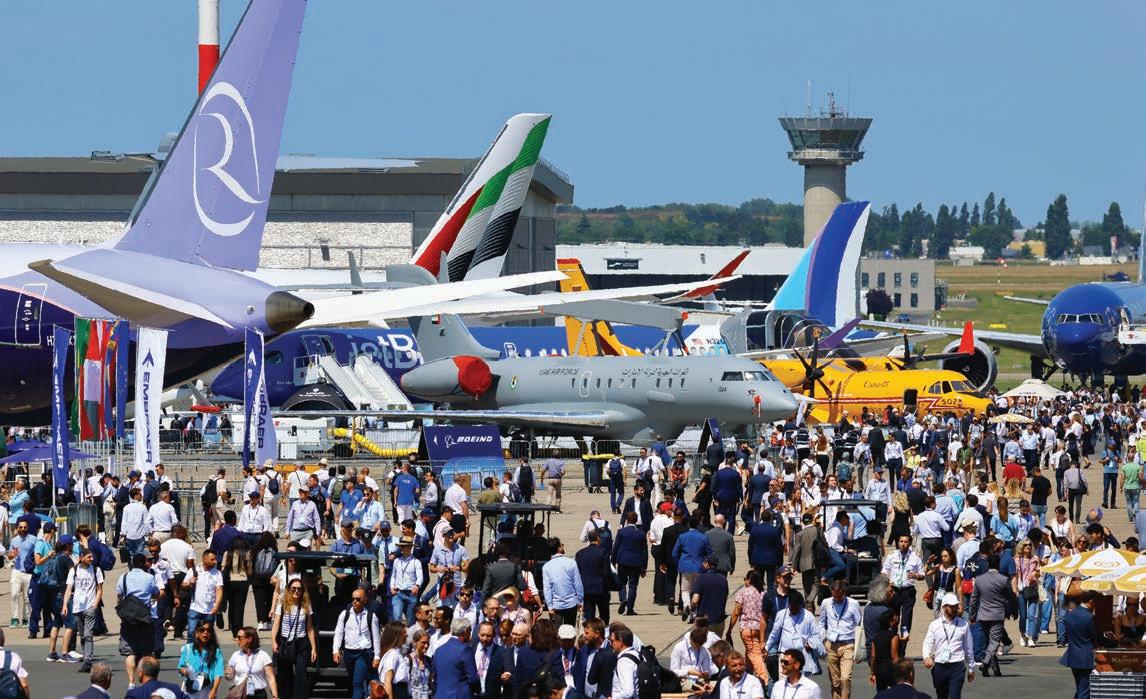
The Paris Air Show attracted 2,400 exhibitors, more than 300,000 visitors, and 155 aircraft.
Escalating military conflicts, looming NATO talks, and aerospace and defense companies absorbing the impact of U.S. tariffs composed a backdrop at the Paris Air Show, positioning it as one of the most consequential in years.
Sensitivities around the geopolitical conflicts were on full display as the show organizers either blocked off or cordoned off most of the exhibits from Israeli aerospace exhibitors. Show organizers erected large black walls around their indoor exhibits the night before the opening of the 55th biennial salon at Le Bourget.
The affected exhibitors claimed discrimination by the French government. A representative from Elbit Systems, one of the companies whose display was obstructed, spoke to AIN on the condition of anonymity and claimed that the move came as a surprise. “It came from the head of the Paris Air Show. It said that following the instructions of the French government, we were supposed to take some items off [display]. They added an annex of which items we were supposed to take off, and unless we did so, they would mask them somehow, block them somehow, cover them. We didn’t know exactly what shape it was
going to take. We didn’t comply at the time. When we came in…we were taken aback.”
Agence France-Presse reported that the French government gave the order due to the display of “offensive weapons,” including those used in Gaza. Show organizers did not respond to requests for comment.
The geopolitical tensions showed in other ways, such as the absence of Russian aircraft on static display and a scaled-down Chinese presence.
But geopolitics did not eclipse the prominent profile of cutting-edge technology during the event. In the absence of major new airliners or military aircraft, hybrid

Corporate Angel Network (CAN) provides cancer patients free seats on jet and turboprop business aircraft to treatment throughout the United States.
anks to the generous support of our partners, CAN has coordinated more than 69,000 patient flights. Can you spare an empty seat or donate to our mission? e space you fill may well be in your heart.
and electric aircraft provided much of the novelty, both on the technological and the order front. Many were on display, including the first certified advanced air mobility vehicle, the Chinese E-Hang eVTOL.
Key agreements were announced, such as a memorandum of understanding signed on June 19 for Lockheed Martin Skunk Works to help Electra Aero accelerate development of its hybrid-electric EL9 ultra-short takeoff and landing aircraft. A day earlier, EASA signed a pre-application contract with Elfly covering the development of a conceptual prototype for its Noemi electric seaplane. The agreement is a step towards achieving type certification for the nine-passenger aircraft in 2030.
Boeing subsidiary Wisk Aero signed agreements with officials from Miami and from Kaga, Japan, to help forward autonomous operations and research in those areas. Daher, Safran, and Collins Aerospace announced that they were collaborating with French start-up Ascendance to develop hybrid-electric propulsion systems for general aviation, among the many other announcements.
At many events during the airshow, executives from various companies extended their condolences and thoughts to the families of the accident victims. Some airshow exhibitors, including Boeing and engine makers CFM International and GE Aerospace, canceled planned events at the airshow due to the accident. In addition, Boeing Company president and CEO Kelly Ortberg and his counterpart at Boeing Commercial Airplanes, Stephanie Pope, canceled plans to come to Paris.

ramping up military spending. However, Accenture global aerospace and defense lead John Schmidt noted that this trend could have unforeseen consequences for U.S. defense contractors. “A shift we’re seeing is a big push for Europe to buy from Europe,” he said.
Perhaps as a sign to that end, Airbus announced that NATO procurement agency OCCAR signed an agreement with the aerospace giant that will see production of the A400M airlifter secured for the foreseeable future, as well as the joint development of additional capabilities and efforts to lower operating costs. Until 2029, production will be stabilized at an optimum rate of eight aircraft per year, achieved by bringing forward build slots for four aircraft for France and three for Spain.
A shift we’re seeing is a big push for Europe to buy from Europe.
In fact, it was an advanced air mobility deal that was the first announced at the Paris Air Show—on Sunday, June 15, when Brazil’s Revo signed a binding contract that will see it operate air taxi services in São Paulo with 50 Eve Air Mobility fourpassenger eVTOL aircraft. The spinoff from helicopter group Omni intends to take delivery of the first 10 vehicles in late 2027, with the others to follow as it scales up the operation.
That agreement was followed by a letter of intent signed with Future Flight Global for up to 54 aircraft to serve the Americas. Overall orders were somewhat tempered after Boeing opted to pull back on its commercial side of the business following the June 12 fatal crash of an Air India Boeing 787-8 Dreamliner in Ahmedabad. The accident claimed the lives of 270 people, including all but one of the 242 passengers.
Even so, orders and options for several hundred aircraft were logged. With Boeing’s quiet presence (it did affirm a previous ANA order), Airbus grabbed headlines with its bounty, most notably bringing LOT Polish Airlines into the fold for the first time with firm orders for 40 and options for another 44 for its A220. This wrested a deal away from long-time LOT customer Embraer. But Embraer still walked away from Paris with a $3.6 billion deal from SkyWest Airlines for 60 E175s and purchase rights for 50 more.
ATR, meanwhile, also brought a new customer into the fold—Part 380 carrier JSX, which is going to trial per-seat public charter service with a pair of 30-seat leased ATR 42s later this year but has a letter of intent for up to 25 more.
Under Trump Administration pressure, European NATO member states are now
Airbus Helicopters and Leonardo are launching a joint architecture study to define the long-term evolution for the NH90 helicopter following a request from the NATO Helicopter Management Agency. The Block 2 upgrade will tackle modular avionics, improve maintenance and performance, and add new capabilities such as crewed-uncrewed teaming and collaborative combat.
Also among the announcements on the defense side of the show: French defense procurement agency DGA selected Saab’s GlobalEye early warning and control platform. The government signed a declaration of intent with the Swedish manufacturer to buy a pair of GlobalEye aircraft, with options for two more. Bombardier provides its Global 6500 for the GlobalEye platform. The deal is expected to be finalized in the next few months and will include ground equipment training and support.
But U.S.-based manufacturers also had their successes. Textron Aviation Defense and Thai Aviation Industries agreed to jointly develop a sustainment program for the Royal Thai Air Force’s Beechcraft

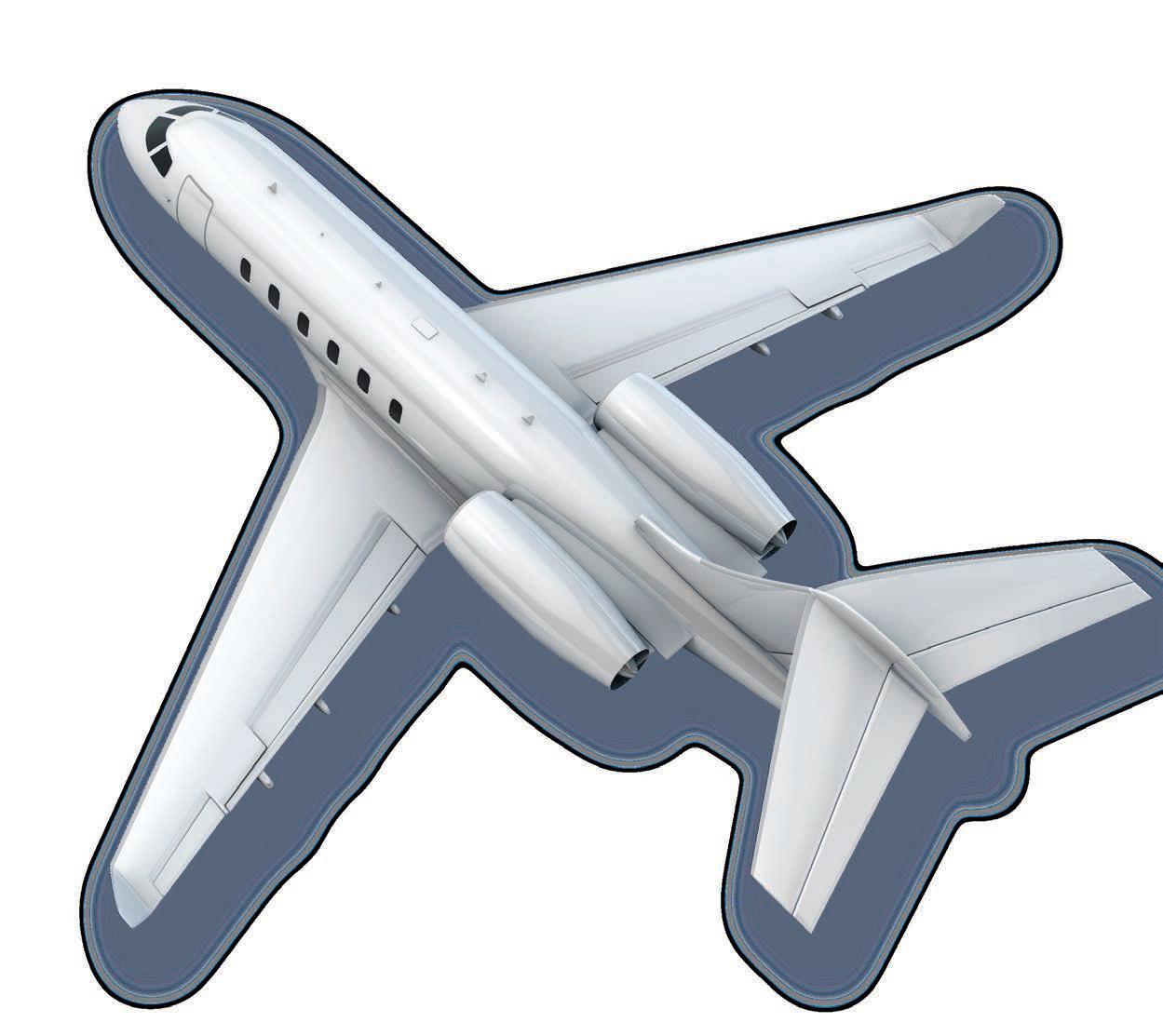
T-6TH trainers and AT-6TH Wolverine light attack/border patrol aircraft. The RTAF ordered 12 T-6THs for its advanced training unit at Kamphaeng Saen and eight AT-6THs to be operated by the 411 “Thunder” squadron at Chiang Mai.
Boeing Defense Space & Security (BDS), meanwhile, said it is pouring billions into Europe, mostly in the supply chain but also in supporting local industry development, as it vies to expand its base there. These include investing in countries such as Poland, which is undergoing a large uplift of modern aircraft into its air force. Polish company PGZ is gearing up to service the fleet of 96 AH-64E Apaches that are soon to be delivered to the country’s air force. In Ukraine, Boeing has teamed with Antonov to rebuild the local aerospace industry, with a small UAV now under development.
As business continued, tariffs were never too far out of the discussions, especially given the July 9 date that had been looming for trade deals to be sealed.
During the airshow, Canada signaled its intent to decouple from its immediate neighbor and forge closer ties with Europe, while U.S. Transportation Secretary Sean Duffy hinted that the Trump Administration may consider removing aviation

from its standoff with what it views as trade adversaries.
Speaking during a fireside chat with Aerospace Industries Association president and CEO Eric Fanning during the airshow, Duffy insisted that the U.S. is using tariffs to rebalance trade deficits. However, he acknowledged that free trade has benefited aviation. “It’s been remarkable,” he said. “The White House understands that. If you go there and see the new parts of what they are doing, it’s a lot.”
On this basis, the U.S. position could be about to change. “I would make the point that we should take aviation off the negotiating table going back to 1979 [when the Agreement on Trade and Civil Aircraft was signed], and that only helps us,” Duffy stated. “This would take negotiation

leverage away from some of our partners, and that would be beneficial to the U.S.”
At the same time, Canadian Minister of Industry Mélanie Joly doubled down on Prime Minister Mark Carney’s position that the country is currently in a “trade war” with the U.S. She applauded the decision by some Canada-based aerospace companies that are diversifying from the U.S. market.
“I think Canadians were shocked by the decision by the Trump Administration in February to impose illegal and unjustifiable tariffs, which later was a direct attack on our workers, particularly in the auto sector and particularly also in the steel and aluminum sectors,” she told AIN. “What businesspeople themselves have seen is that they need to do much more east-west business, not necessarily north-south like how Canada is currently organized. Our strategy is to make sure that as a government we can lead the way, and then businesspeople are able to benefit from the opening of doors that we’re doing, particularly now in France and in Europe.”
All of this put the Paris Air Show in the center. AIA’s Fanning noted that the show presents an opportunity to highlight to the global stage that the U.S. remains open for business. Importantly, in the context of the Trump Administration’s tariff policy, AIA also viewed it as an opportunity to signal to political leaders in Washington, D.C., that the U.S. industry has long delivered a positive trade balance for the national economy.
Washington has taken notice. Not only was Duffy present at multiple events, but Capitol Hill sent its largest contingent yet to the Paris Air Show, with members in the House and Senate attending. Typically, only a few lawmakers, primarily from the Senate and with a defense focus on their plates, attended in the past.
But with a new Capitol Hill this year and many urgent global issues, key leaders made sure they had a seat at the table in Paris. z
—The AIN Paris Air Show News team contributed to this report
Dear Reader,
Now in its seventh year, AIN Media Group’s Solutions in Business Aviation returns in its updated format—appearing as a dedicated sponsored content section within the August issue of Aviation International News. Introduced last year, this format continues to deliver timely insights and innovative solutions from across the industry.
As business aviation evolves, so does AIN Media Group. With the recent acquisitions of Aircra Post and Leeham News and Analysis, we’ve expanded our reach and strengthened our ability to provide data-driven content that supports the industry.
is year’s edition of Solutions in Business Aviation focuses on a key challenge: how to prioritize and invest in new technology. With innovation moving at a rapid pace, industry leaders are making critical decisions about where to focus resources for long-term value. eir insights are featured throughout this special section.
Please enjoy.
Lisa Valladares Director of Marketing & Client Services lvalladares@ainonline.com




Through 75 years, three rebrandings, and thousands of aircraft modifications, repairs, and overhauls, two things have remained constant: the name Stevens and the commitment by the generations of Stevens Aerospace and Defense Systems team members to deliver on the promise to treat every customer like a friend.
Every owner has a personal bond with their aircraft. So it’s no surprise that “personal service” was the number one reason so many owners choose Stevens as their MRO provider.
“During the recent meeting of the Stevens Aerospace Customer Advisory Board, we asked our customers why they bring their aircraft to us,” explains Phil Stearns, Director of Sales and Marketing for Stevens. “While our array of services and technical skills was high on their lists, the overwhelming reason was knowing that our team members truly care about them and their aircraft.”
As one attendee says, “When I’m here, I don’t feel like a job ticket, but a person with
individual needs, and they listen to me. I have the phone numbers of our Stevens contact and the lead technician. I don’t know of any other MRO that provides that level of personal service.”
“Too many businesses today are caught up in the self-centered who we are and what we offer mindset,” Stearns adds. “But we look at it from a who our customers are and what they need perspective, and then concentrate our efforts on delivering the best solution. That simple thing is a big differentiator today.”
And don’t think the company’s dedication to personal service is a flavor of the day. Its “customer first culture” actually dates back to the 1940s, when it began as the in-house main-
tenance provider for a small fleet of airplanes operated by the J.P. Stevens and Company.
“No matter how our business has changed, the one constant has been the culture that we all genuinely care about our customers,” adds Emily Hamilton, Stevens’ Marketing Manager. “In aviation, everything must be done by FAA regulations, but those regulations are just a starting point for us.”
“We go beyond compliance and create relationships that go back decades,” she continues. “That’s the key to building our 75-year legacy.”
“IT’S JUST WHO WE ARE.”
Sure, any service provider can say they deliver a great customer experience, but in too many


instances today, those words have a hollow ring. But, at Stevens, that commitment might as well be etched on the aircraft’s data plate.
“Each customer has a dedicated representative, and it’s their job to know how their customers use their airplanes,” Hamilton says. “Our customers are welcome to walk into the hangar and talk directly to the technicians working on their airplanes. Trust is all about transparency.”
“ Our customers are welcome to walk into the hangar and talk directly to the technicians working on their airplanes. Trust is all about transparency...”
And while basic technical skills can be easily learned, it takes a great deal of time and attention to pass along the “tribal knowledge” critical to continuing the company’s legacy.
“Probably the greatest thing I can think of to describe Stevens is that we have a lot of seasoned experience here that you don’t find elsewhere,” says Stevens Aircraft Mechanic Philip Coleman. “For some of these airframes, you could call technical support, if available from the OEM, but it’s so much better to ask someone here who has done that job before.”
Too true. So much legacy experience can’t be found in any instructions or documentation. The only way to keep that information alive is by passing it from technician to technician.
“New technicians work side-by-side with Stevens’ veterans, and their experiences get passed along through these daily interactions. These mentorships strengthen not only our technical knowledge, but also our customer service culture,” Hamilton says. “When that knowledge sharing surrounds a technician, it sticks with them. The high value we place on our people is one reason we have team members stay here for their entire careers.”
Stearns stresses that these mentorships are also foundational for building the kinds of long-duration, mutually beneficial customer relationships Stevens is known for.
“In order to do that, we need to understand their world the best we can,” he says. “It’s not a five-minute conversation or something you can fill out on a form—it’s a commitment to long-term listening, interacting, and being there when they need us.”
To illustrate his point, Stearns shared a story of when he and one of the Stevens representatives had dinner with a visiting customer and their spouse, whom the representative had known for several years.
» Big capability, small company feel.
» At Stevens, you don’t get lost in the system. As a family-owned business for 75 years, we’ve scaled our services without losing what matters most — personal relationships, open communication, and a genuine understanding of our customers.
“The conversation ranged from college days to grandkids to dogs and finally to their airplane,” Stearns says. “At the end of the evening, the owner’s spouse asked how he remembered all those personal things about their family. He said, ‘Well, it’s easy when you care about someone.’”
“That kind of personal investment builds a level of trust that is earned and shared by customers. It makes a huge difference,” Stearns continues. “It doesn’t matter what the service is; what matters is that the customer knows that we will work to solve the issue with their best interests in mind.”


For nearly 70 years, Western Aircraft has provided high-quality MRO services to business aircraft operators throughout the western U.S. To help ensure that their service level continues, the company is implementing an array of programs to attract, train, and retain the best technical talent.
The Golden Rule of the MRO industry is, “Those who have the best A&Ps and avionics technicians rule.” And that’s created fierce competition among commercial and business aircraft maintainers to attract and retain the best from the shallow pool of new talent entering our industry.
“These challenges aren’t on the horizon –they’re here now,” says Sharon Hamilton, director of human resources at Western Aircraft. “The aviation industry must rethink how we attract, train, and retain talent if we want to stay ahead of workforce shortages.”
However, instead of lamenting the problem, Western Aircraft has been developing and implementing a range of new programs and initiatives to enhance its ability to meet the growing demand for skilled aviation technicians.
One of the most ambitious efforts is to proactively reach out to state and local educators to inform teachers, students, and influencers that business aviation offers a variety of high-paying career opportunities.
“Young people don’t even realize that aviation is a career option,” Western Aircraft’s Director of MRO Operations, Brody McKenna, says. “It’s not only A&Ps, but upholsters, cabinetry, painters – so many other disciplines that skilled workers may not even consider being tied to aviation.”
Of course, the need to attract new talent to aviation is only overshadowed by the requirement to train them to the highest FAA standards – and that’s the goal of another of Western Aircraft’s recent initiatives.
“We started a new entry-level A&P training program that helps us to get them up to speed faster,” Hamilton says. “Someone with zero experience can work here for three years and be ready to test for their A&P certificate. They become a very valuable addition to our team in a very short time.”
“It’s not just hiring and training, we’re also concentrating on retaining these profession-

als,” she continues. “We’ve introduced our Syllabus Program, which creates a defined career path for our A&Ps and avionics technicians. They see where their career can go with us. It’s been a very effective retention tool.”
McKenna stresses that while building its workforce with trained and motivated technicians is its primary goal, secondarily, their efforts give Western Aircraft’s customers confidence in knowing that their aircraft are being cared for by dedicated professionals.
“Many of our customers have been with us for a long time, and they know we’re in this for the long haul,” he says. “We are doing what we need to do to continue to be their MRO service provider of choice – today, and for decades to come.”

» Introduced a three-year, in-house A&P apprentice training program
» Real-world experience working on everything from turboprops to large cabin business jets
» Created a clearly defined career track for A&P and avionics technicians to promote retention
Whether it’s a quick AOG fix or a complex avionics/connectivity upgrade, for over 40 years, Thornton Aviation has continually built upon its reputation for not only providing the highest levels of technical quality but also excelling in the fine art of delivering an exceptional customer experience.
When looking for a new maintenance provider, one of the first questions an experienced flight department manager or DOM will ask is, “What sets your MRO apart?”.
Most answers will include longevity, technical capabilities, FAA and OEM authorizations, and the like. This is all well and good, but only the fortunate few will begin with their people “Our people and their depth of knowledge and experience are what sets us apart,” explains Thornton Aviation’s Chief Revenue Officer, Don Milum. “We have nearly 1,000 years of combined expertise with the Bombardier, Dassault, Gulfstream, and Textron models we specialize in. That’s pretty incredible and is a huge benefit to our customers.”
commitment to exceptional customer service and responsiveness. “If you call us, you talk to someone who cares about meeting your needs,” Milum says. “Our managers can act quickly to provide a solution, and our team will ‘throw everything at a situation’ to get the airplane out when promised.”
With locations at Van Nuys and Burbank—two hotbeds of business jet activity—transient aircraft AOGs are SOP for Thornton Aviation’s team.
» FAA Part 145 Repair Station Certificate approvals for more than 60 business aircraft types
» Convenient locations at Van Nuys (KVNY) and Burbank (KBUR) airports
» Services range from AOG repairs to heavy maintenance and avionics/connectivity upgrades

“But it’s not only the technical experience that sets us apart. It’s also the fact that many of our technicians worked for flight departments before joining the Thornton Aviation team,” he continues. “That gives us the unique perspective of being able to look at an aircraft and its operation through the eyes of the owners. We understand their perspectives and the pressures that go along with operating a successful flight department.”
That “operator’s perspective” has been the foundation of Thornton Aviation’s unyielding
“It’s not unusual to see 10 AOGs on our ramp in the morning, with half of them gone by midday and the rest gone by the next morning,” Milum explains. “Our AOG experience is phenomenal. There is rarely a problem we have not solved before, and that means our customers can manage their operations with minimal disruptions and downtime.”
Much of the Thornton Aviation team’s ability to solve issues quickly stems from its experience handling large-scale repair and maintenance tasks, such as airframe repairs or completing complex cockpit/cabin electronics upgrades.
Milum explains that when you put it all together, Thornton Aviation “is the right people with the right skills and right attitude—and those aren’t buzz words. Our customers know who we are and what we do,” he says. “And it all starts with putting their needs first in everything we do.”
Go ahead. Take a look. (818) 787-0205 or visit www.thorntonaviation.com.
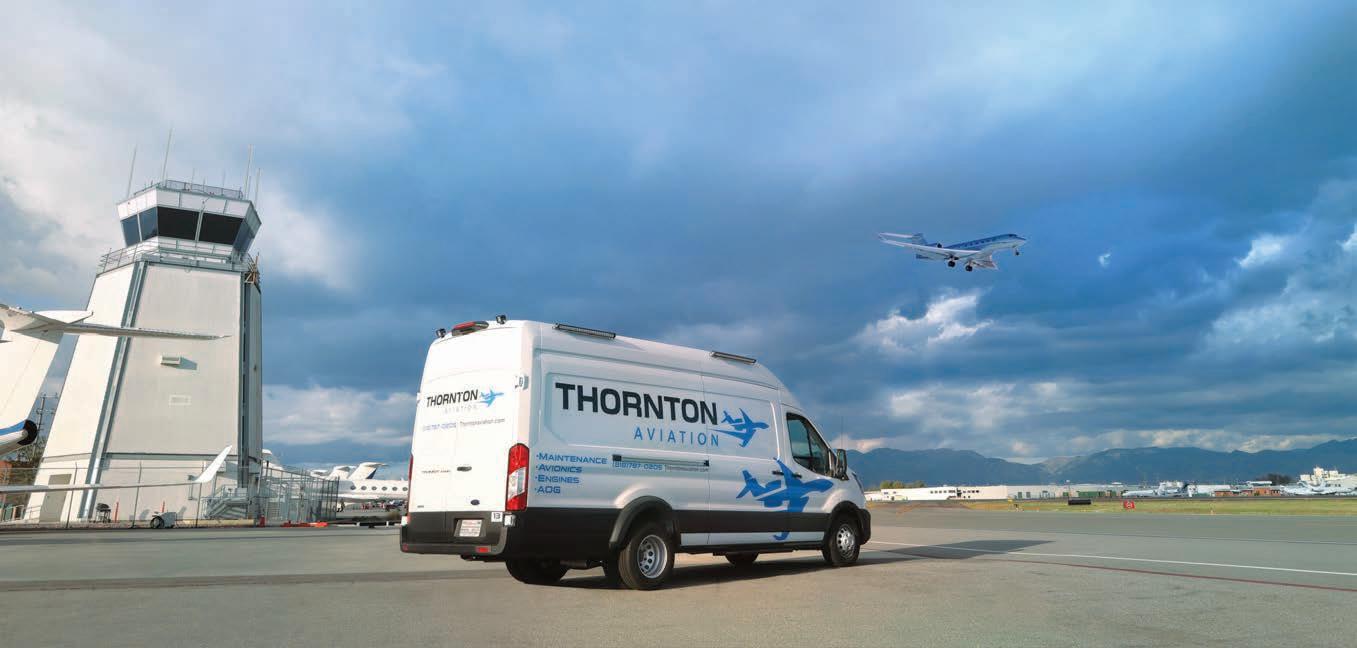

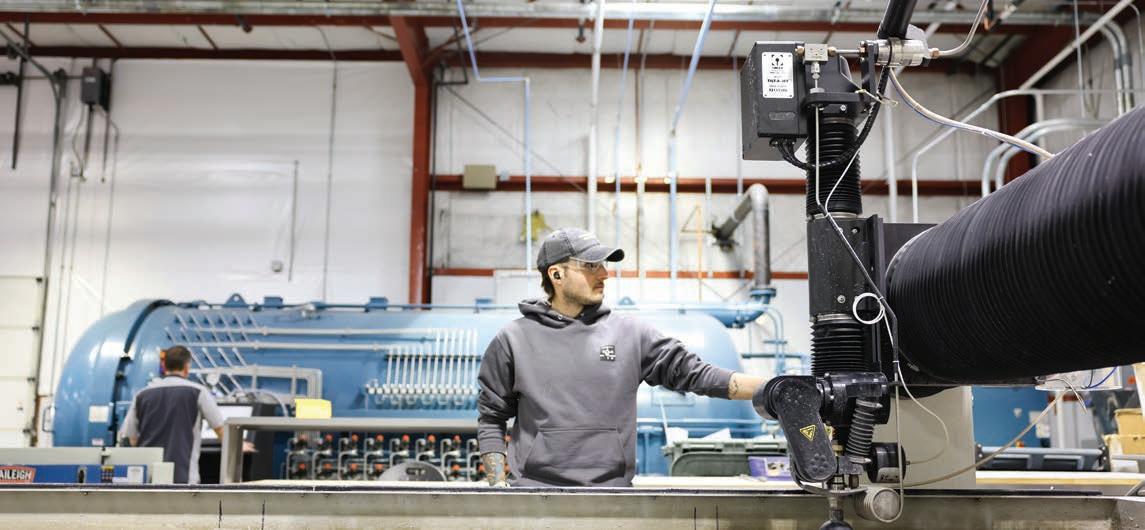
Built on its vast experience providing installation-ready parts for Duncan Aviation’s MRO services, Duncan Manufacturing Solutions has become a trusted provider of cost-effective, FAA-certified parts manufacturing and certification services for business aircraft owners, OEMs, and MROs.
While business aircraft OEMs would love to be able to stock the vast array of replacement parts their aircraft will need throughout their service lives, that’s just not possible.
It stands to reason that when you see as many business aircraft come through your network of MRO facilities as Duncan Aviation does, sooner or later, you will face that very problem.
However, while that may create a seemingly insurmountable situation for many MROs, meeting that need is precisely why the company created its Duncan Manufacturing Solutions (DMS) division.
Scott Stenka, the manager of Duncan Aviation’s DMS, explains that the company’s growth into becoming an FAA PMA parts
supplier started when it was heavily involved in completing “green” aircraft for OEMs.
“Back then, aircraft OEMs didn’t ‘complete’ their aircraft interior and paint, so we had to design and manufacture a variety of parts for our avionics and interior installations,” he says. “That was the beginning of our relationships with many of the OEMs. They saw what we could do and started to come to us when they needed a specific solution.”
“So, when an OEM needs one, 15 or 150 parts, they come to us because it’s what we do every day,” he continues.
Stenka says the company received its FAA PMA authorization in 1983 to manufacture saleable parts to support Duncan Aviation’s aircraft completions and STC programs.
Of course, while Duncan Aviation had all these in-house engineering, testing, manufacturing, and certification capabilities, it made sense to utilize them to support its other MRO activities.
An example is when a legacy jet came into the Duncan Aviation Lincoln MRO for maintenance, one of the control surfaces needed to be replaced. Unfortunately, the OEM had no replacements available.
“The OEM had the old 2D paper drawings of the piece – it was designed in the ‘60s – but we were able to recreate the part and deliver it faster and more cost-effectively than they could,” explains Scott Stenka, Duncan Manufacturing Solutions Manager, Duncan Aviation. “We ended up making eight sets of flight controls. Their normal suppliers just aren’t interested in producing such small numbers of parts.”
And being able to solve those types of situations didn’t go unnoticed by the aircraft OEMS.
“Another project we did for one large business jet OEM was to manufacture and certify parts that they were having a hard time getting
from Europe,” he continues. “They gave us the plans to do a PMA Letter of Assist so we could make the parts they could sell outright to customers.”
“Today, Duncan Manufacturing Services provides a full range of manufacturing and certification solutions for OEMs,” Stenka says. “So, when an OEM needs one, 15 or 150 parts, they come to us because it’s what we do every day.”
He explains that DMS’s “one-stop-at-one shop” capabilities put it in a unique position to provide everything from conception to manufacturing and testing, as well as AS 9100D and ISO 9001:2015 certifications.
“And we can do it all quickly,” Stenka continues. “All these years of supporting Duncan Aviation’s MRO projects, as well as the variety of OEM needs, have put pressure on us to work quickly and efficiently, and that is what we are best at. Doing what others can’t is who we are.”
Of course, it takes the right tools and training to make all this happen. “In 2021, Duncan Aviation established a program to grow the capabilities of Duncan Manufacturing Solutions as a stand-alone entity, and they supported that with a $4.1 million investment in our facilities and tooling,” he adds.

Today, DMS’s “home” is a 21,000-squarefoot, climate-controlled complex located at Duncan Aviation’s headquarters in Lincoln, Nebraska. Stenka proudly explains that the investment includes the latest manufacturing capabilities, including CNC milling, sheet metal fabrication, composite manufacturing, additive manufacturing, forming, heat treating, and finish painting.
“These new capabilities allow us to expand our manufacturing offerings into more challenging and complex parts fabrication projects,” he says. “Where some see challenges, we see opportunities to leverage our skills to
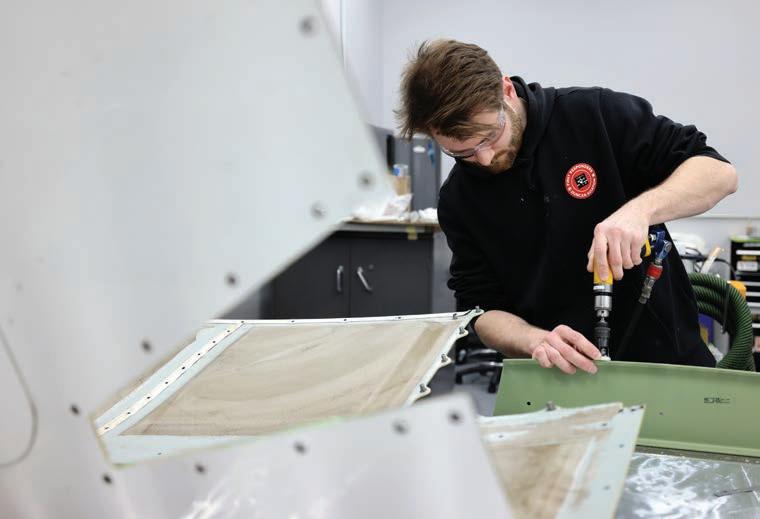
quickly and cost-effectively deliver critical parts to our OEM and MRO customers.
While the types of work they do and their tools may have changed over the decades, Stenka stresses that Duncan Aviation’s commitment to providing the company’s legendary service has remained the same. “The Duncans have invested a lot of money in ensuring that it can continue to direct its course and not have to rely on layers of management,” Stenka continues. “No one else can support their customers the way we can, and that’s a big reason our customers continue to trust Duncan Manufacturing Services to meet their needs.”
» Over 40 years of manufacturing everything from single-piece parts to complete parts packages
» Only MRO with FAA PMA, FAA DER, AS 9100D, and ISO 9001:2015 certifications
» Manufacturing, and certification services deliver parts faster and at a lower cost
What new technology or service is your company introducing and why have you prioritized this investment?




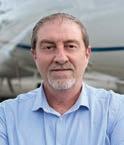

ALPHACHOCK MAX is the world’s first and only carbon fiber aircraft chock. It is also the first to be produced using the new aCC-Procedure (Automated Composite Compression Process), which was recently developed by our Swiss Supplier, Nägeli AG, in collaboration with ETH University of Zürich. This new technology allows us to optimize design while controlling weight.
Daniel Stieger, Founder, ALPHACHOCKS
Duncan Aviation provides comprehensive engine services, including MPI, CZI, HSI, and maintenance. We are adding a second test cell, shop space, and tooling to our engine overhaul facility for P&W Designated Overhaul Facility status. DOF completion in early 2026 will better support clients and increase demand for all our MRO services.
Mike Minchow, President of Duncan Aviation
Over the past 20 years, we have seen how dynamic and ever-changing this industry can be. To meet today’s challenges, we recently hired a chief technology officer and have invested in new technologies to increase the efficiency of our operations, provide safe and secure payment solutions for our clients, and better communicate with our crew members around the globe.
Denise Tuite, CEO, Jett Group, Inc.
The NAA is proud to prioritize environmentally friendly fuels, such as Sustainable Aviation Fuel (SAF) and UL 94, reinforcing our commitment to environmental responsibility and community well-being. By embracing cleaner alternatives, we’re helping shape a more sustainable future for aviation while supporting the health of our planet and the people we serve.
Christopher Rozansky, Executive Director, Naples Airport Authority
Our priority is delivering high-quality repairs while minimizing downtime and cost. A major step forward was bringing Cadmium Plating capabilities in-house and investing in tooling, chemicals, and training. We’ve also formed a strategic partnership with a major engineering solutions and services provider for structural repairs and modifications..
Don Milum, Chief Revenue Officer, Thornton Aviation
Western Aircraft is tackling the industry talent gap with a forward-thinking strategy: engaging future technicians through school partnerships, accelerating skills with hands-on A&P training, and fostering growth with clear career paths. These investments ensure exceptional service today—and build the expert workforce our customers can count on for years to come.
Brody McKenna, Director of MRO Operations, Western Aircraft
SPONSOR CONTENT

our Safety Action Team reviews safety data and trends, developing risk management strategies and sharing them with sta ff and tenants alike.”
Recent airfield safety improvements include:
When flying into Naples Airport—the welcoming gateway to Florida’s Paradise Coast— you’re probably thinking about beaches, sunshine, fishing or golf. We are dedicated to helping you get there safely and with a smile.
“Safety has been our top priority for decades,” says Christopher Rozansky, Executive Director of the Naples Airport Authority (NAA). “We’ve had a comprehensive occupational safety program in place since 2001.

In fact, our dedicated Safety Manager implemented our Safety Management System (SMS) in place two full years before the FAA made it mandatory in 2023.”
“All NAA employees complete annual safety training, which includes safety responsibilities, how to identify risks, and how to speak up when something doesn’t seem right,” explains Rozansky. “And every month,
– Relocating Taxiway A3 to meet updated FAA standards
– Improving visibility at the Alpha-Bravo taxiway intersection, a noted FAA hotspot
– New vehicular perimeter roads at both ends of Runway 5-23 to minimize crossings
Naples Aviation, the NAA-run fixed-base operator (FBO), continues to earn national recognition for its efforts. Just last year, it became the first FBO in North America to earn the Base Ops Pro Certification from ARGUS International, recognizing elite standards in safety and operational performance.
Our procedures and policies are routinely audited by independent experts to ensure we’re not just meeting standards—we’re setting them,” Rozansky says. “It’s a proactive, top-to-bottom safety culture reinforced amongst employees, tenants and businesses.”
Naples Aviation has also achieved IS-BAH
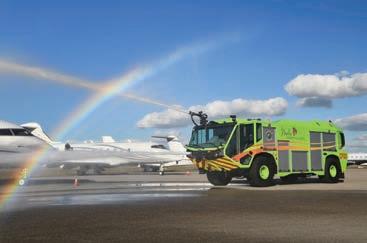
» First FBO in the U.S. to earn the Base Ops Pro Certification from ARGUS International
» Holds both IS-BAH Stage 1 and Stage 2 Certifications for operational and safety processes
» NAA recently implemented an SMS program two years before being mandated by the FAA
Stage 2 certification, one of the highest international safety milestones in business aviation handling. Louis Sorrentino, CEO of AvMaSSI and Chair of the IS-BAH Standards Board, praised the achievement, calling Naples Aviation: “A shining example of what the U.S. FBO industry should look like.”
Awards and accolades are meaningful, but for the NAA it reflects a long-term commitment to building an enduring culture of safety throughout the airport and FBO. “We’re committed to creating the safest environment possible— and that means encouraging every employee, tenant, business, flight crew and passenger to be engaged,” Rozansky says.

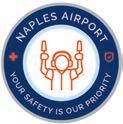

From a “third pilot” for a single trip or a permanent addition to a flight crew, Jett Group has been providing highly trained, vetted, insured, and experienced pilots, cabin attendants, and maintenance technicians to business aviation operators for over 20 years.
Regardless of the reason, every flight department will eventually need to find a highly qualified pilot, cabin attendant, or technician to fill a temporary opening. Even in today’s tight employment market, it is not as impossible a task as it seems.
“In 2004, a major business jet OEM needed experienced pilots for demo flights, deliveries, and other short-term situations,” explains Troy Tuite, President, Jett Group, Inc. “I was one of those pilots, and seeing an unfilled need, we formed Jett Group, Inc. Today, we are a staffing company that specializes in providing qualified pilots, cabin attendants, maintenance technicians, and ASOs (Armed Security Officers) to private and business operators around the world.”
“All our account managers are professional pilots and are experts with the most popular
business aircraft models,” he says. “Combining that expertise with a commitment to service, our team takes great pride in finding the right professionals to seamlessly integrate with each client’s operation.”
Jett Group has also eliminated one of the flight department’s biggest headaches –dealing with all the required paperwork for temporary crewmembers. Tuite stresses that all temporary crew members are Jett Group “employees,” so clients are not paying individual salaries, insurance, training, or taxes. This also provides the owner/operator with protection from a host of liability worries.
» Providing experienced flight crews and maintenance technicians for all business aircraft models
» Flight crew members trained to the latest applicable FAA, EASA, and CAA/DGCA standards
» Certified Woman-Owned business vetted and approved by multiple government agencies
“It is an on-demand situation. When a client calls, we take care of it all, which makes it extremely easy and cost-effective,” he explains. “Our customers have the flexibility of choosing the expertise they need, when they need it, without all the overhead of a full-time employee.”
Speaking of getting experience on demand, Tuite says one of Jett Group’s more popular services is providing ‘third pilots’ to operators to fill their staffing needs during seasonal peak travel situations.
“There is also a growing need for pilots with experience flying in certain locations worldwide, and we have pilots who know the regions and have the appropriate visas,” he explains. “They know the local language, ATC operations, airport facilities, and ground services. Having them onboard provides a great peace of mind for our clients and their permanent crew.”
“No matter where they are flying or what aircraft they are maintaining, our customers have the peace of mind in knowing that every Jett Group crew member is highly trained and a professional member of their permanent crew,” Tuite says. “We only work with people we know and trust, creating a seamless staffing solution for any operator.”

By eliminating all the problems associated with wooden or rubber wheel chocks, the forged-aluminum, foldable, and lightweight ALPHACHOCKS may well be one of the most significant innovations in improving aircraft ground handling safety since the invention of the FBO.
Throughout his 40-year career in corporate aviation, Daniel Stieger had seen too many instances where his company’s aircraft were placed in potentially dangerous situations, simply because the FBOs at remote destinations lacked a simple set of wheel chocks.
Because of these situations, his policy was to have each crew carry six chocks on the aircraft. The problem was that the rubber chocks were heavy and dirty, and they took up valuable luggage space. And they could easily catch under a loaded aircraft’s wheel and risk damage to the tire and landing gear.
After retiring, Stieger made it his goal to develop a wheel chock that was as modern as the aircraft it was meant to protect.
“The biggest misconception was assuming that any chock was ‘good enough.’ But they’re really not,” Stieger states. “Wooden chocks could slip out in the wind, and rubber chocks are too bulky. I wanted something lightweight, super-strong, foldable, and easy to use.”
The result is his line of 100% Swiss-made, forged aluminum ALPHACHOCKS.
“The folding feature was the game-changer; it brought simplicity and portability while allowing the ALPHACHOCKS to lock under the wheel and over the dead-center, so it never slips or gets stuck,” he explains. “There are other metal chocks out there, but noth ing like ALPHACHOCKS.”
Another problem with legacy wooden or rub ber chocks is that their generic dimensions meant
they weren’t always up to the task of securely stabilizing every aircraft type.
Stieger eliminated that problem by designing AL PHACHOCKS in three sizes: the forged aluminum MINI for aircraft weighing up to 45,000 pounds MTOW, forged aluminum MID for aircraft up to 145,000 pounds MTOW, and the super-strong carbon fiber MAX for aircraft up to 780,000 pounds MTOW.
“The ALPHACHOCK MID is our flagship model,” he says. “It can secure any aircraft from single-engine turboprops to F-15s to Chinook helicopters to ultra-large-cabin business jets. It’s the most versatile foldable, aluminum chock in the business.”

While ALPHACHOCKS have been created to be more convenient and easier for business aircraft flight crews to use, Stieger says that they’re equally beneficial for aircraft handlers working at FBOs and MROs and even ACFT MFR like Pilatus chose to have 2 ALPHACHOCKS MID on all PC24 as standard equipment.

“Beyond just aircraft safety, their light weight (10 to 20 times lighter than rubber chocks) and ease of use make a big difference for people moving and securing aircraft on ramps and in hangars,” he explains. “They don’t have to risk injuries carrying or squatting down under aircraft with bulky, heavy chocks. ALPHACHOCKS are not just better for aircraft; they’re better for people, too.”
» Lightweight, foldable, forged aluminum wheel chocks add safety and security to parked aircraft
» Designed for easy removal to eliminate possible landing gear damage due to “stuck” chocks
» Available in sizes to safely secure aircraft ranging from single-engine turboprops to 747s
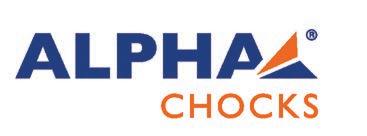



BY AMY WILDER & MATT THURBER

Charter operator Jet Linx grounded all flight operations on June 10 to hold its ninth annual Safety Summit, bringing together more than 500 employees for a day of scenario-based training and discussions focused on safety culture and decision-making.
“Safety: Beyond the Checklist,” this year’s theme, encouraged team members to reflect on communication, leadership, and personal accountability in operational contexts. Sessions included topics such as fatigue management, airspace awareness, and real-time decision making. Employees also renewed safety pledges and recognized peer contributions to safety leadership over the past year.
Jet Linx estimated that the annual standdown represents more than $850,000 in lost revenue but emphasized that the investment aligns with its long-term safety priorities.
The Omaha-based company has voluntarily paused all operations for the event each year since 2017. This year’s summit featured keynote speakers including former NASA chief astronaut Charlie Precourt, human factors expert Rich Loudon, and Major Tyler Hicks of the U.S. Air Force.
“A healthy safety culture is when every single team member is engaged in the safety thought process every day,” said Jamie Walker, executive chairman of Jet Linx. “And while this is just one day out of 365, the fact that we continue to commit this kind of time and resources year after year shows just how meaningful it’s become to every member of our team.”
During the event, director of safety Patrick McGuire raised some interesting questions. Asked about whether the current flight training environment is meeting the needs of the industry, Precourt cited a need for more in-depth scenario-based training and academic understanding. “Regulations haven’t kept up, and many type ratings are treated as a ‘license to learn,’” he said, not a final product.
“We get what we regulate,” said Loudon. “There’s still too much repetition of outdated maneuvers like rejected takeoffs. Meanwhile, key areas like pilot monitoring, one of the most common factors in incidents, aren’t required in practical training.”
Military training is different, explained Hicks. “In the military, training must be mission-specific and push pilots into challenging, uncomfortable situations. At least
in the military, the goal is to make training harder than real life to prepare crews for worst-case scenarios.”
Raising the issue of how management can avoid unintentionally pressuring crews to push the safety envelope, McGuire asked the panelists how to prevent this.
“Define who holds operational control,” Loudon said. “Too many decision-makers create confusion. Everyone contributes expertise, but the pilot must be free to make safety calls without pressure.”
Precourt agreed: “Pressure often hides in good intentions. Leaders must ensure that incentives don’t conflict with safety. One voice saying ‘this isn’t safe’ should outweigh schedule demands.”
“Unlearn the mindset of ‘we’ve always done it this way,’” Hicks explained. “We often say that procedures are written in blood. But that doesn’t mean procedures can’t evolve. Know the rules, understand their origins, and be willing to question them when they no longer serve safety.”
“Leadership must create an environment where it’s safe to speak up,” Loudon added. “Junior captains often hesitate. Not because they lack skill, but because they doubt themselves in high-pressure situations. That hesitation can be costly. Leaders must develop trust and communication quickly, even with unfamiliar crews.”
McGuire asked the panelists what “beyond the checklist” means to them.
Hick responded: “Know the checklist, but be able to operate when it doesn’t apply. Adapt and speak up. Leaders must expect and support this behavior.”
Precourt further said: “‘Beyond the checklist’ is about interpersonal dynamics. Checklists won’t save you if people don’t communicate effectively.”
And Loudon added: “It means lifelong learning. Even seasoned professionals need to keep growing.” z
BY MATT THURBER

More than 50 years since the founding
There are probably few pilots who don’t recognize the famous teaching couple, John and Martha King, and the company they founded, King Schools, to help teach new and existing pilots everything except the actual flight training. The company celebrated its 50th anniversary last year, and John and Martha are still actively flying their Dassault Falcon 10. As holders of almost every pilot certificate and rating in existence, they seem to have run out of further certifications to pursue.
Over the years, the Kings have learned a lot about flying and the meaning of safety. After nearly killing themselves a few times, they gained a healthy respect for the importance of safety margins and evaluating and mitigating risk. They have also emphasized that the commonly repeated claim about driving to the airport being riskier than general aviation is actually a myth. According to statistics, the
opposite is true, and the Kings haven’t shied away from sharing this data. Rather than endlessly repeat bad information, such as the airport-driving myth, they would prefer to see pilots, especially new ones, embrace the concept of risk management. As John King says, “Flying is not safe. It’s a risky activity,” and he and Martha are not afraid of the controversy that this statement generates.
How did you come to understand the concept of risk management?
Two weeks later, an FAA guy called me and said, “John, I thought you’d want to know Dr. Parsons is dead.” That’s how long it took him to kill himself. He was very impatient. Of course, that’s not a good risk-management philosophy.
Martha: Dr. Parsons was the culminating thing. But we would go back to cities on a routine cycle, and it was not uncommon for students to show up in the class and
John: We were doing weekend ground schools. I had a student who was both an Episcopalian priest and a radiologist who just didn’t follow the conventions of a classroom, and I felt he probably wasn’t patient enough to make good risk-management decisions. I went to the FAA inspector who was coming to give the test on Monday morning and said, “You’ve got to talk to Dr. Parsons. He’s going to kill himself.” And he said, “I can’t just go pick some guy out of your class and talk to him, just because you said so. He’ll call his congressman.” I think he said, “You talk to him.” I swore [and thought], “No, I’m not gonna talk to him. I’m just a ground instructor, and he’s this [influencer] in his community.” Neither one of us talked to him, and so we went home.
say, “Do you remember Bill, who was here six months ago with me?”
John: We said, “What happened?” He said, “He got killed.”
Martha: We accumulated people like this, whom we had taught, some of whom we’d gotten to know very well. Dr. Parsons was just a final straw.
John: I felt very guilty about Dr. Parsons and that I hadn’t intervened. We decided that never again were we going to let someone put a guilt trip on us like that. If the situation came up, we were going to intervene, and then we began to feel that way about the whole aviation community. We felt what the FAA was doing [was] all scram bled up, that the FAA’s and everybody’s vocabulary about safety wasn’t helpful. We felt that we needed to have a new vocab ulary, a new way of talking about it. And you’ll notice that we keep throwing in risk management because we think safety is the goal, but the way you get there is you iden tify the risks and mitigate them.
Martha : Airplanes are built to fly for various purposes, military, commercial, fun, but anytime you start any kind of motorized vehicle, whether it’s an air plane, a boat, a car, a truck, a snowmobile, you’re undertaking some amount of risk.
John: It’s safer to leave the airplane in a hangar. But that’s not what people do, and that’s not what we want to do. We want to fly the aircraft, and you cannot do any activity in an aircraft without some degree of risk. Our job as pilot in com mand is to identify those risks and mitigate them.
Was there an example after Dr. Parsons where you intervened and felt you were able to get your message through?
Martha : We were coming back from Las Vegas on a dark and stormy night. It was dark and windy, and there was a lot of turbulence over the mountains east of San Diego, coming in from Las Vegas. We were in a Citation.
John : The marine layer was all the way from the coast, right up against the mountains, and this guy is calling approach control and saying, “Can you vector me towards a hole in the clouds?”
Martha: He said, “I want to climb through
John: I got on the radio, he’s talking to the controller, and I just interrupted. I said, “Tonight is not your night to go to Las Vegas. Not in a 172 with four people on board.” And as I said, we’re in a Citation. It’s rough. We didn’t like it. We wouldn’t do it again.
Martha: There are no holes. The clouds go all the way to the mountains. If you’re not instrument-rated, you’ve got no business being out here. He turned around, called the controller back, and said, “Can you vector me back to Gillespie?”
John : Then the controller said, “Thank you.” I didn’t feel bad about intervening.
Martha : That’s the most direct one that we’ve done since then, but we’ve tried [intervening] through our risk-management talks that we started doing about 30

: We want to do an approach in a vocabulary that is acceptable to the listener, that is respectful. As pilot-incommand, it is your job to mitigate the risks. We don’t say, “go/no-go.” That’s not the decision. The decision is: Can you change the way you go to mitigate the risks? Can you go at a different time, or different altitude, or a different route, or change the load? It’s not: “You can’t go.” You want to mitigate the risks. That guy on that particular night shouldn’t have gone. But in general, we need to think about the risk, and we may decide that we can’t mitigate the risk, but that’s how you get a safe result as you identify and mitigate the risk.
You’ve both talked about your experiences and some fairly risky behavior. Did that scare you straight?
John : Sometimes we don’t pick up on things as quickly as we should. We would scare people. We would come home, and the people who cared about us would give us a lecture. Many times, we felt the lecture was not particularly beneficial, but we slowly picked up on the idea that if we care about people, we’re scaring them, and we need to change our behavior.
Martha : We also scared ourselves sometimes. One time, going into San Antonio in the Citation, we left fuel off out of San Diego because it was cheaper in San Antonio—after all, we’d have plenty of fuel to get there. And then they got an upslope condition, and it got foggy for like 500 miles. It became a case of we’d better make this ILS approach successfully, because we don’t have enough fuel to go anywhere else. [These incidents] make you resolve that there are more important things than getting the lowest fuel price somewhere, and there are better ways to manage the [flight].
Is risk management and mitigation a fundamental part of your courses?
John : [Now] it’s a fundamental part of virtually everything we do. It got that way [because] we didn’t like being talked down to. People talk about aeronautical decision-making. I have a hard time with that concept because I don’t understand how that’s di ff erent than any other decision-making. And people talk about, “You don’t have judgment.” The problem with judgment is it’s a demeaning thing to say, and it gives you no guidance. What we try to do is be positive and tell you something you can do, how you can do it, and why it’s practical for you to do it. It’s part of the idea of how you teach people…by giving them guidance and things that can help them.
Martha : We were doing ground school classes and following along with what the FAA was asking about, which was not risk management at that point. Because of the people that we knew [were] killed in airplanes, people who were respected and admired, who were friends and good people, we were very annoyed with people we thought were good pilots. Why did they do what they did? We developed these risk-management talks and got good feedback on them. As we revised the courses
after we were doing the talks, and with the FAA, we started putting in risk management because we thought it was important. Even if the FAA wasn’t asking questions in that manner, it was important for the people we were teaching to get it, important for what we felt our purpose was.
Was there any kind of pushback because people didn’t grasp the concept?
Martha: There was a lot of pushback because it was common to say one pilot to another, “The most dangerous part of the trip was the drive to the airport.” That would absolutely be true if you were flying commercial, but not if you were flying general aviation.
John: People felt that it wasn’t supporting the aviation community properly by acknowledging that it’s a risky activity. We took the accident rate per 100,000 hours and converted it to an estimated accident rate per mile, and, when compared to the automobile accident rate, it was not true. It would be seven times per mile more likely to be involved in a fatal accident in a general aviation airplane than in a car. People didn’t like that. They didn’t want to admit it. We call it the big lie. The big lie is one you’ve told long enough and often enough that you believe it yourself. But that doesn’t mean it’s not a lie. It is.

Was it hard to bring this discussion up and teach the instructors how to teach it?
Martha : There is still a significant issue with flight instructors. We worked with a lot of DPEs [designated pilot examiners], and they are complaining that a lot of flight instructor applicants don’t know how to take a practical test and how to [use] scenarios. The general feeling is that [there is a] big push to get a lot of pilots through the pipeline to get to the airlines, and this has deteriorated the seasoning of flight instructors.
Is there a favorite kind of flying for each of you?
John: It depends on what you want to do. If you want to fly VFR and see things beautifully, you find a helicopter; it’s a perfect way to see things on the ground.
Martha: We fly our R22 in Southern California. It’s just an incredibly beautiful way to see the countryside. If you want to get somewhere in a hurry, a small jet is the way to go. We fly an old Falcon 10. I enjoy instrument flying very much, because I like the precision of it and the 3D building of the picture that you need to know where you are, where the airport [and] the approach are, the other airplanes, and everything that’s going on.
John: The most difficult thing we’ve ever flown is a blimp. A helicopter is hard to fly, but at least it does what you ask it to do. You can ask a blimp to turn left, and it’ll take a long time to go left. We used to have passengers come up and say, “Are these controls hooked up backwards? You’ve got full left, and the airship is going to the right.” We said, “That’s why we have full left.” It takes a while to respond, so people think the controls are hooked up backwards.

Is it worth owning such a classic airplane like the Falcon 10? It must be hard to find parts or service.
Martha: We bought it in August 2001, and yes, it’s been worth it.
You hit on a sore point: the parts are getting difficult for the 10s. We went through a C check last summer, and basically, the shop waved us goodbye after what was supposed to be six weeks and turned into four months. They said, “We don’t want to see you again because we can’t get parts for you anymore.”
We’ll likely change to something else in the next [few] years, simply because the maintenance is high on a Falcon 10. It’s a real thrill to fly and it’s very solid.
You’ve seen a big shift in technology in general aviation. Has this helped improve safety?
Martha : Situational awareness, as far as terrain, airspace, also other traffic, if they’ve got ADS-B In. They can look at the airport they’re going to and they can tell if there’s any tra ffic...which runway they’re using, and they can spot somebody’s on downwind, somebody’s on base. There’s an
enormous amount of situational awareness that just was never available to us before.
John : I think technology can and does improve our ability to identify and mitigate risks.
Martha: That brings up the issue, and we have a lesson on this in our flight instructor refresher courses, of the flight instructor needing to work with a student on how and when to use [tablet apps], what the pitfalls are in terms of having databases up to date, your charge, properly downloaded [databases], and how to make sure you’re still looking outside the airplane and not just staring at your tablet.
John : What are you going to do if you drop your iPad? It’s a real risk because many times you can’t reach the iPad on the floor without unbuckling your seatbelt. Those are things the instructor needs to teach a student, that one of your risks is dropping the iPad, and don’t let it kill you. It could.
What are some of the risks that you see that still need to be addressed?
John : When we see a room full of pilots who learn to fly over an extended period using physical skills, mental skills, and emotional skills, and putting them all together and becoming pilot in command...you see a room full of goal-oriented people. Now, goal orientation in most things in life is a wonderful thing. But as a pilot, it is a risk factor because people hate to give up on a goal, and they persist when they shouldn’t. They want to complete their goals. We need to have the aviation community recognize that their goal-setting behavior is the biggest risk.
We’re kind of our own worst enemies…
John : Exactly. You need to mitigate that risk and make plans for not getting there. What are your alternate ways of dealing with it, so that you will be willing to give up on a goal?
Martha : DPEs... [will] set up a scenario where you have a rough-running engine, which should stimulate you to go to some alternative. I’d go through the checklist to see if I can figure out what’s wrong. And if that doesn’t solve anything, I would pick out an alternate airport, and I’d go there. The DPE says, “Well, do that,” and [the applicant] doesn’t have a clue how to do it because they never did it in their flight training. They only talked about it. Doing it, particularly if you have to figure out how to get into the pattern for a non-towered airport, is not easy when you’re under stress and on a check ride.
Is scenario-based training a weak area?
Martha : A number of schools put out applicants who have not been trained using scenarios. They’ve been trained more on physical maneuvers...but there had been no scenario set up where they have to think about managing risk and managing alternatives. They show up at the check ride, and the DPE puts them in a situation that requires risk analysis and mitigation,
and they haven’t been trained for it.
Are you seeing any trends in accidents that point to areas we need to work on?
John: One of the difficulties we’re having now is that many pilots are soloing with a flight instructor. We’re told that insurance companies are requiring a flight instructor, that they can’t send a person out on their own and solo. My concern is...are you creating a pilot in command when they can’t go out on their own?
Martha: There’s a big difference between going with somebody qualified, sitting there, allegedly keeping their mouth shut in the other seat, and not having anybody else in the airplane with you and understanding that you’re responsible for getting yourself down on the ground alive. DPEs we talked to are complaining
about people showing up with almost no real solo time because they’ve got, instead of real PIC time, particularly for the commercial, they’ve got “acting as PIC” with another pilot on board. People are hoping that maybe the FAA will change that.
How do we train pilots to handle external pressure?
John: The fundamental thing is you have to figure out an alternative to your problem and be willing to give up on a goal.
Martha: Pilots have to be comfortable with the PIC requirement to manage the expectations of their passengers, whether they’re paying or free, whether they’re celebrities or family or just a friend.
John : We need to manage our own goal-setting behavior. z

BY MATT THURBER
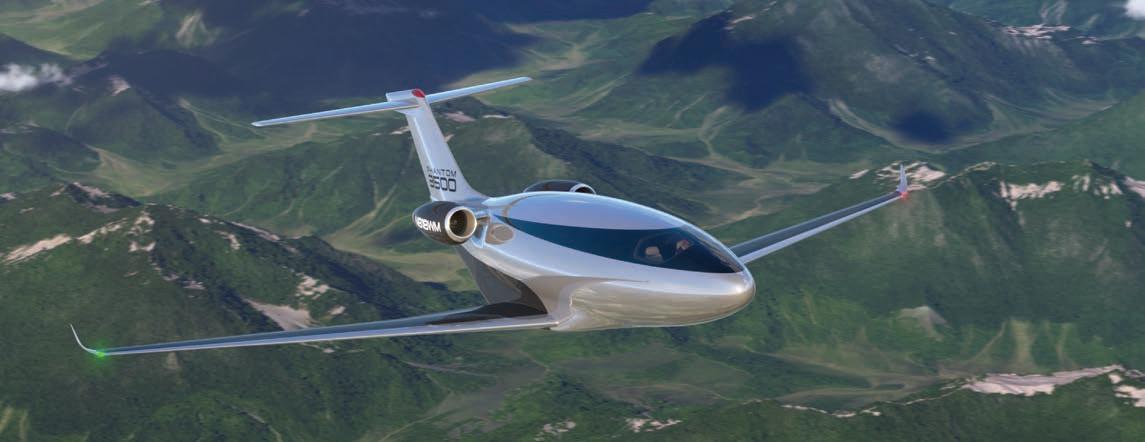
The all-composite Phantom 3500 light jet will feature a windowless
After exploring the benefits and application of laminar-flow aerodynamics with the Celera 500 experimental aircraft, Otto Aviation is embarking on the challenge of bringing a clean-sheet business jet to market. The U.S. company insists its Phantom 3500 isn’t yet another light jet, promising to match the performance and comfort of existing midsize jets at light jet prices and operating costs with an aerodynamically sleek all-composite airframe that has no passenger windows.
Examples of clean-sheet jets coming to market are relatively rare, and the process is costly and time-consuming. The HondaJet took 12 years from first flight of the prototype to certification and reportedly cost billions to develop. The singleengine SF50 Cirrus Jet first flew in 2008 and achieved FAA certification in 2016, and this was a program run by an experienced manufacturer, although this was also its first turbine-powered airplane.
Otto Aviation has been working on the
Phantom 3500 for three years, and the Celera 500, which was powered by a Red A03 diesel engine, did generate useful data on laminar-flow aerodynamics, according to CEO Paul Touw. “It had unbelievable results,” he said. “And that’s what led to the ability to move forward, to build the actual first product.”

PAUL TOUW CEO, OTTO AVIATION
Having completed the systems requirement review and conceptual design, Otto in January validated some of its suppliers.
In October, Touw expects to finish the preliminary design review, “which means the design will be completely finished. Then we are ordering parts for the first aircraft, flight test vehicle one.”
Items with long lead times have already been ordered, including the landing gear from Mecaer and FJ44-4 QPM engines from Williams International, for arrival by the end of next year. The next step will be assembly of the first Phantom 3500, systems- level testing, and first flight in 2027. Certification is planned by 2030.
The U.S. start-up has switched its energy to the Phantom program after previously working on a hydrogen-powered 19-seater called the Celera 750. This design, which was announced in June 2022, would have used a ZeroAvia hydrogen-fuel-cell powertrain to deliver range of up to 1,000 nm.
The Phantom 3500 design is supported by $25 million worth of wind tunnel
testing, according to Touw. This included wing cross-section tests at NASA’s Ames Research Center in Mountain View, California; slow-speed handling characteristics tests in Wichita; and high-speed tests at the European Transonic Windtunnel (ETW) in Cologne, Germany. “All three of those tests were successful,” Touw said. “Our prediction on that [drag polar] curve, and what we tested in the ETW, were almost within a couple of percent of each other, so we had an extremely accurate confirmation of our design.”
When comparing the Phantom 3500 with other aircraft, Otto is competing with midsize and super-midsize business jets. With NBAA IFR range (four passengers, 100-nm alternate) of 3,200 nm, the company says the Phantom’s Williams engines should burn 60% less fuel than the Bombardier Challenger 3500 or Embraer Praetor 500 and 600, according to Touw. On a 1,000-nm trip, the Phantom would burn 115 gallons of fuel while the larger airplanes would burn 300 gallons, “and we do it in the same amount of time.”
The Phantom’s flat-floor cabin is 6.4 feet tall and 7.5 feet wide with a volume of 800 cu ft, compared with the Challenger 3500’s 930 cu ft cabin, which is 6 feet tall and 7.2 feet wide. At 40,600 pounds mtow, the Challenger is a much heavier airplane, about twice as heavy as the 19,000-pound Phantom. The two-pilot, Part 25-certified Challenger can carry four passengers 3,400 nm versus the Phantom’s 3,200 nm, which it achieves by flying higher at its maximum altitude of FL510, 6,000 feet higher than the Challenger’s FL450.
A more apt comparison might be with Honda Aircraft’s in-development Echelon, which also aims to deliver midsize jet performance in a light jet package. The Echelon’s range is lower at 2,625 nm, and it will carry up to 10 passengers and cruise at 450 knots, about 20 knots slower than the Phantom and Challenger 3500. The Echelon’s maximum altitude is FL470. Like the Phantom, the Echelon will be certified
under Part 23 regulations and will also be a single-pilot jet.
The Phantom 3500’s wing is swept 23 degrees and will have leading-edge slots. “That helps create a bit of a vacuum pressure that pulls laminar flow back on to the wing, all the way back to almost 85% on the top of the wing and almost 100% on the bottom of the wing,” Touw explained. “So the wing is almost 90-plus percent in laminar flow, even at Mach .80 and even with a 23-degree sweep. It’s the combination of the right sweep, the right shape of the wing, and that slot that creates these conditions to almost re-laminarize the back of the wing. It’s a pretty magical trick, because if you can get that wing in almost all laminar flow, it almost disappears from a drag perspective.”
The design feature that should enable the Phantom 3500 to be most efficient at its maximum altitude is the laminar flow reduction of skin friction drag. “You can afford to make the wing bigger, and that’s what allows us to fly at a higher altitude,” Touw told AIN . “We have a much lower wing loading than most business jets, [which is in the] 80s or 90s [pounds per sq ft]. Ours is in the 50s. That’s what allows us not only to climb much faster; we take off fully loaded…and get to 51,000 feet in about 28 minutes, and then that’s where it likes to fly. We don’t have to step climb to get to 51,000 feet.”
Otto will build four Phantom 3500s for the flight testing and certification program, all of which Touw said will conform to the final design, thus eliminating the step of producing a non-conforming prototype. The airframe is all-composite, and Leonardo will build the fuselage at a facility in Grottaglie, Italy. Touw didn’t identify the wing manufacturer. Garmin G700 TXi displays will be installed for the flight test program.
The unique airframe with no cabin windows is designed to contribute to natural laminar flow on the fuselage. One window is required for the emergency exit that will be in the lavatory in the rear fuselage. Instead of windows, passengers’ view of the outside world will be on 42-inch 4K monitors on the cabin walls, four on each side. Touw sees this option as more comfortable for passengers, especially at the FL510 maximum altitude.
Otto Aviation has raised nearly $200 million for the Phantom 3500 and is about to launch a series B funding round, although it is likely that the program will require well more than $1 billion to make it through to certification and production. The company employs about 100 people and supports another 200 full-time equivalent contractors. Manufacturing will be done at a new factory at Cecil Field in Jacksonville, Florida. “We have to purchase all of our expensive equipment and tooling,” he said, “so we have a lot of other expenses. [But] we’re well funded,” Touw said. z
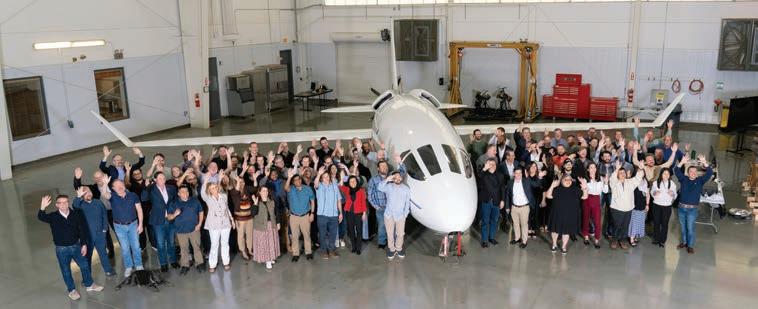
BY AMY WILDER

On my way to Brennand Airport (79C) in Wisconsin on a hot summer day, I found myself wondering what it would be like to fly Pipistrel’s all-electric Velis Electro. I knew a little about the history and development of the aircraft, but not what it actually felt like to fly it. I suspected it might be more like its parent gliders than my more ponderous Cessna 172 experiences.
EASA approved the Velis Electro on June 10, 2020, making it the world’s first fully electric aircraft to receive type certification. In March 2024, the FAA granted the Velis Electro a light-sport aircraft airworthiness exemption for the U.S., making the aircraft a viable training option for schools. By that time, the 100th Velis Electro was on the production line.
When I met with Anthony Nicodemo, sales manager for dealer Lincoln Park
Aviation, I soon discovered that the experience combined familiar stick-and-rudder handling with the unusual propulsion characteristics that distinguish it from traditional combustion-engine trainers.
Preflight checks are familiar but include unique electric-specific considerations. The Velis has two liquid-cooled lithium-ion battery packs with a total capacity of 22 kWh. Power output and battery status are displayed on the instrument panel, along with the familiar “six pack” of instruments that provide information about attitude, airspeed, altitude, and heading. General flight planning looks a little different because there is no fuel weight (or declining fuel weight) to take into account. Useful load is a fairly narrow margin between the takeoff max of 1,320 pounds and the airplane’s empty weight of 944 pounds. On
a hot day or at higher altitudes, especially when a student and CFI share the cockpit, some careful calculations will need to be made.
Starting the engine is simple: flipping the master switch and throttle-equivalent lever brings the Pipistrel E-811-268MVLC electric motor to life. There is no mixture to manage, and no magneto or engine instruments checks, without the combustion engine. Startup feels smooth, with the three-blade propeller responding quietly and immediately to the power setting.
Taxiing is straightforward, though rudder inputs on the ground felt stiffer than I expected until we were rolling. “Mash the pedals to loosen them up,” Nicodemo advised. With a wingspan of approximately 35 feet, wingtip clearance is a consideration on narrow taxiways. Although
the wingspan is similar, the sight picture di ff ered from that of the familiar Cessna 172, making me uncomfortable when passing open hangar doors and aircraft on the ramp while on Brennand’s narrow taxiway. The toe braking felt familiar and was responsive, which was comforting.
Takeoff was smooth and nearly silent. Acceleration was linear to full power. Rotation speed is around 45 to 55 knots (not much slower than the 172), and once airborne, we climbed out comfortably at 60 to 65 knots. The aircraft’s climb performance feels respectable for a trainer, but it draws significantly on battery reserves at full power.
A mid-level cruise power setting yielded about 75 to 80 knots. Pipistrel says cruise power can be set at 20 to 36 kW, with the high-power setting delivering a cruise speed of 93 kias at sea level. The aircraft is responsive and light on the controls, aided by push-pull tube-connected flaperons. Turns, slow flight, and maneuvers all felt intuitive, with very low cockpit noise and no vibration from a combustion engine. Thinking in terms of battery power and state of charge, rather than throttle/
mixture and RPM, would take some time to adjust to, but generally speaking, flying the Pipistrel feels like, well, flying an airplane.
During a simulated turn-around-a-point exercise, the Velis remained stable and easy to control—somewhat boring, if I’m honest, which is a good sign; the aircraft handles predictably enough that the exercise didn’t require much extra thought or input from me on the controls. The quiet operation and immediate power response made pattern work a pleasure. Sight picture and trim response required some acclimation, and throughout the flight, I found myself inadvertently losing altitude until I adjusted the nose attitude and trim appropriately.
Landings are conventional with aerodynamic slip options in the absence of power adjustments. Approach speeds are between 60 and 65 knots with partial or full flaps deployed. We had a light crosswind with some gusts, so the aircraft’s light weight and low inertia required attentive control inputs. A stall-warning buffet could be felt through the stick in the final moments of the flare.
The charging time post-flight is

Dimensions and Weights:
Wingspan: 35.1 feet (10.71 meters)
Length: 21.3 feet (6.47 meters)
Height: 6.76 feet (2.06 meters)
Maximum Takeo Weight (mtow): 1,320 pounds (600 kg)
Empty Weight: 944 pounds (428 kg)
Maximum Endurance: Up to 50 minutes, plus 10-minute reserve
Takeo and Landing Performance: Takeo Distance over 50-foot Obstacle (mtow): 1,470 feet (448 meters)
Stall Speed with Flaps: 46 kias
approximately three hours for a full cycle, yielding 50 to 60 minutes of usable flight time with a 10-minute reserve.
In the air, the Velis Electro handles much like a Cessna 150, but with increased responsiveness and reduced noise. It is ideally suited to its intended role as a short-leg trainer, offering modern avionics, intuitive power management, and a quiet cabin environment. While range limitations prevent it from being a cross-country aircraft, its certification and operational simplicity make it a strong contender for beginner training.
The questions I am left with as a potential owner or operator would be how the charging time for the aircraft’s battery will balance with operating time. How efficient is it for a flight school to have to block a minimum of four hours for each training flight, to account for the long charge time? How much infrastructure would need to be adjusted to accommodate charging, e.g. charging stations on the ramp? And what sort of operating costs would result from three, six, or even nine hours of charging time per day to feed the airplane’s battery? z
BY MATT THURBER
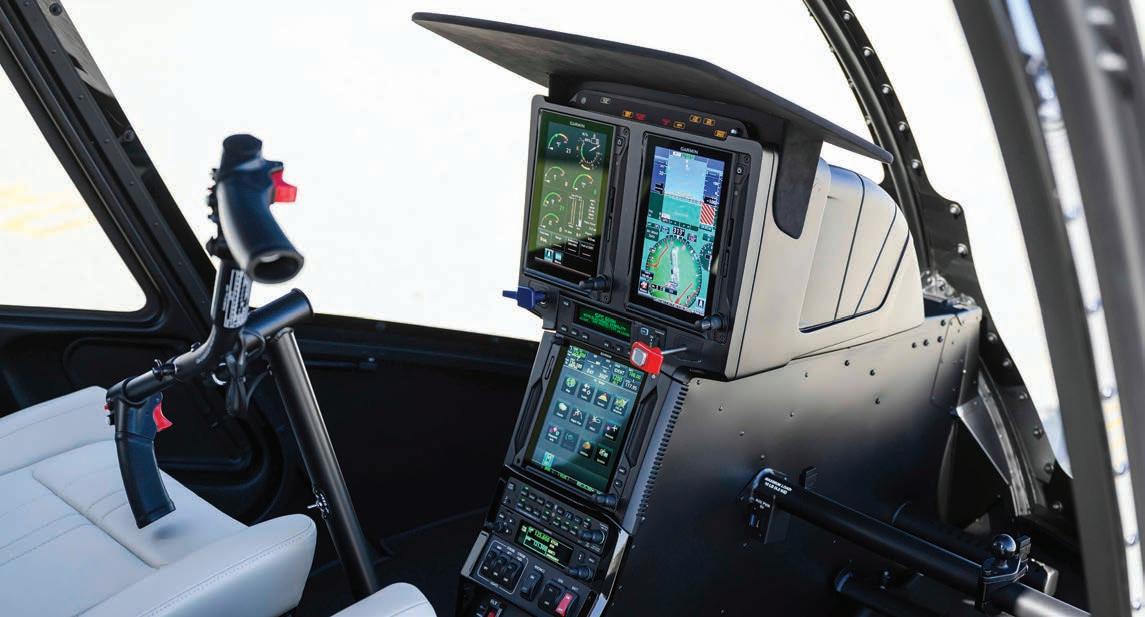
new training program will help pilots make the most of the R66
With FAA certification of the Garmin GFC 600H helicopter flight control system in the Robinson R66, Torrance, Californiabased Robinson Helicopter is making the two-axis version of the autopilot a standard feature. R66 NxG helicopters with Garmin avionics and the autopilot will begin delivering early next year.
R66 buyers have long had the option of adding Moog’s two-axis Genesys HeliSAS to the R66, but the Garmin autopilot is available with an optional third (yaw) axis. Buyers of R66s with serial number 1510 or later can amend their order and switch to the GFC 600H, according to Robinson. The optional third axis is priced at $25,000.
To learn how to use the autopilot most effectively and in concert with the R66 NxG’s Garmin avionics suite, Robinson has developed a two-day avionics and autopilot class. The first will be held in September, appended to the end of the company’s safety course.
In addition to the GFC 600H, the R66 NxG is equipped with Garmin’s touchscreen G500H display with engine data and optional synthetic vision and GTN 635Xi GPS/com (a GTN 750Xi is optional).
The GFC 600H autopilot can be operated with cyclic-mounted controls. In addition to hover assist (GPS-based position hold), airspeed stabilization, and heading
hold, the autopilot’s modes include altitude capture and hold, vertical speed hold, airspeed hold, heading select, navigation, and approach. Unique Garmin features include helicopter electronic stability and protection with limit cueing that nudges the controls when the pilot pitches or banks beyond certain limits; LVL mode, which returns the helicopter to straightand-level flight; low-g protection; and low-altitude protection, which alerts pilots and automatically engages a pitch mode change to help recover to a safe altitude. Some of the autopilot features will be available full-time, and pilots won’t be able to turn these off without pulling circuit
breakers. “It’s an incredibly valuable tool, and we make it difficult to turn off,” said Robinson president and CEO David Smith. “It’s intentionally a passive system. Even if you don’t have it in one of the modes, it’s protecting you from the low-g condition, as an example, and you could always engage it with LVL mode in an emergency situation.”
While Robinson is working on certifying the G600H autopilot in the R44, it won’t be immediately available as a retrofit for older R66s, according to Smith. “We’d expect that, in time, a factory overhaul will be available to add the Garmin [autopilot] to older ships that would be difficult for us to do in the field. We’re evaluating our options on how to offer this.”
Robinson dealers will be the first to participate in the two-day avionics and autopilot training so they can share information with R66 buyers, but any pilot will be able to take the course. “Now is the time where we’re going to start educating folks a lot more about the functions, the modes, and what we consider to be these passive safety features that are incredible,” he said. “That push button level, that’s the one that excites me the most. I’ve seen, unfortunately, in my time here, several cockpit videos of pilot disorientation captured in our 4K cockpit cameras that we put on the aircraft, and they’re very often fatal. This push button on the cyclic, push to level, will save lives. It’s incredible, and it is responsive.
“In the long term—let’s think 20 years out—these should be features we can offer to all products at all levels in the rotarywing space,” Smith said. “Garmin has done a great job developing a combination of high-fidelity, highest-safety-standard software, and the weight package of it is smart. I feel like if ever we were going to go through this as an industry, we should do it now. We’ve got all the ingredients to make a huge step change in safety. The older aircraft… it will be difficult to do a modification for something like this, to install magnetometers and to do the HIRF-hardened wiring
that’s required. Those examples will be difficult. And I know people sweat every little dollar they have to spend. But…we’ve got to get over it as an industry, we’ve got to go into the hard things like this.”
Later this year, Robinson plans to announce a partner for a new training program that will incorporate virtual-reality simulators and focused, scenario-based training modules tailored to the safety issue that a particular operation faces in its location. “I want something so that a pilot can sit down, don the right equipment, and select scenarios that [replicate actual problems],” Smith said. “We’ll develop scenarios and push those through to the network of simulation that will be extremely important for evolving safety. Accidents we see in the field can inform this.”
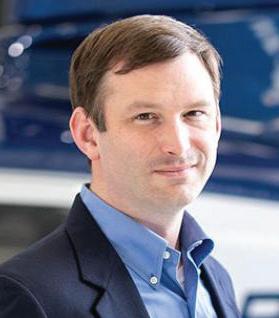
DAVID SMITH
ROBINSON HELICOPTER PRESIDENT AND CEO
Part of this training and simulation program will include some gamification to incentivize pilots to participate and add to their skills.
Smith has worked in the flight simulator industry and doesn’t think the existing regulator-mandated commercial pilot training protocols are beneficial. “The tragedy of commercial aviation is we give them two shots every year to make them the best pilot in the world, and all we do is hold them to a maneuver threshold that they know the maneuver, they know the airports, they know the routes, they know the tests, they know the instructor, they know the story. It’s all the same, so you don’t really exercise them much. It’s just threshold-based thinking.”
Smith wants to motivate pilots to grow beyond those traditional training paradigms. “I want incentivized growth. I want them to be gamified, competitive, incentivized.” This could mean a kind of leaderboard, where top-performing pilots in the training program are ranked anonymously. If a pilot doesn’t make, say, the top 20%, they may want to get back in the simulators and try to improve. “We want to drive that in a way that exists in so many things out in the world,” he said. “It’s crazy to me that it has not existed in aviation, [and] it’s a big part of how I think we unlock this next level of safety that is getting pilots to compete with each other, to try to be the most proficient.”
The addition of the Garmin autopilot and avionics to the R66 will contribute to improving pilot training as well, Smith explained. “The thing I really love about the Garmin autopilot is that there’s a lot of digital data that it stores and gives us insight into control positions and use of the aircraft in all kinds of situations. Over time, I’d expect we’ll have the ability for data coming off NxG ships to offboard control positions to understand excursions, how active people are on the sticks. Those are where I think you get an indication of pilot proficiency and pilot risk that’s unmined and untapped today. All of that is useful science to be developed with lots of good data. I love that the Garmin autopilot is going to have a rich data trail to it, and we’ll be able to better understand the use of the aircraft.
“Every accident, there’s a lot of things to learn about, and today we use cockpit video cameras as a significant aid. If I had control positions and the pilot’s activity in a more digital format, that’s going to be even better. And I can pipe that right into a simulation and use that as a scenario. Even if it’s not one that people actively fly, people can feel the conditions of that aircraft throughout its entire accident flight. And I think it’s great for educating people, just in an experiential way, rather than lecturing.” z
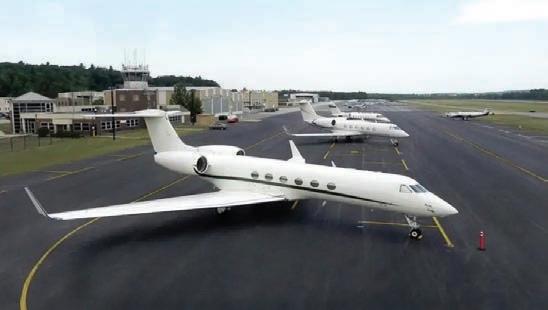
A new service provider chain has launched with the acquisition of a New Hampshire FBO. Infinity Aviation Group, the lone service provider at Nashua Airport/ Boire Field (KASH), has been purchased by a group led by industry veteran Steven Levesque and backed by infrastructure investment manager Igneo. Levesque, previously president and CEO of Leading Edge Jet Centers and Hawthorne Global Aviation Services, said it will retain the name Infinity Aviation, and he intends to develop the brand into a national FBO chain.
The location—just 50 miles from downtown Boston— offers airframe, engine, and avionics maintenance and repairs to both piston and jet aircraft. It provides jet charter sales and management, as well as aircraft sales.
In a separate transaction at KASH, Infinity acquired holdings of aircraft hangar operator Nashua Jet Aviation. That brings it to more than 150,000 sq ft of hangar space on the field.
Azure Flight Support is adding a third location to its network, and its first outside of Tennessee, with the addition of the lone FBO at Maryland’s Salisbury Regional Airport (KSBY). The company won the RFP process issued by the airport last year and took over the facility from incumbent Bay Land Aviation, which was not among the operators to submit proposals.
The 3,600-sq-ft single-story facility features a pilot lounge, flight-planning area, concierge, crew cars, and refreshment bar. Azure will begin an immediate renovation on the two-decadesold terminal, and it plans to build a 4,500-sq-ft replacement terminal within the next two to three years. The complex also includes an above-ground 32,000-gallon fuel farm and 16,000 sq ft of hangar space capable of sheltering light jets.
Azure was given a 20-year lease for the facility, along with a 10-year renewal option. Its other facilities in Tennessee are at Smyrna (KMQY) and Crossville Memorial (KCSV) airports.
Private aircraft customers at Saint Martin’s Princess Juliana International Airport (TNCM) will see an upgrade in FBO facilities as the airport authority turns its redundant temporary arrival facility (TAF) into a general aviation terminal (GAT). The 7,500-sq-ft TAF was built to handle commercial operations after TNCM’s terminal was ravaged by Hurricane Irma in 2017. The main terminal took seven years to restore, fully opening late last year.
ExecuJet and Signature Aviation, which provide business aviation services at TNCM, are based in small temporary structures on the field. They have negotiated with the airport authority to build new FBOs or a shared GAT, befitting the airport’s status as one of the major Caribbean gateways for the private jet and yacht set. The companies are preparing for the move into the temporary facility, which is undergoing renovation. It is set to reopen as a GAT this month.
Each service provider will occupy approximately 1,200 sq ft in the terminal, with the remaining shared space housing border control, customs, and the airport authority security screening area. Restrooms in the arrival and departure area in the GAT will be shared by the FBOs as well. ExecuJet received a 10-year lease for the facility, which will be managed and operated by the airport. Signature expects to sign a similar term agreement.
TNCM is the primary stepping stone for private jet passengers heading to the ultra-luxe enclave of Saint Barthélemy (St. Barts), which—due to the small size and short runway of its airport—is best suited for the singleengine turboprop flights that run between the two islands.
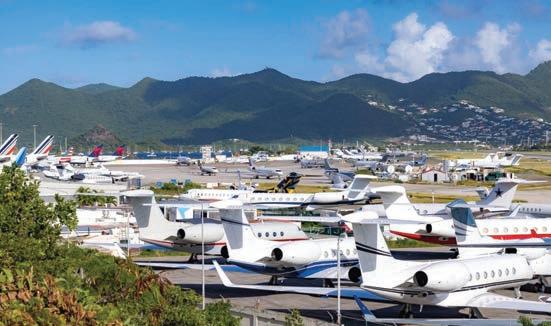
For Wilson Air Center, a small but highly regarded FBO chain, 2025 represents its 20th anniversary as a service provider at Houston’s bustling William P. Hobby Airport (KHOU). One of six FBOs on the field, the company recently renovated its facility, with the $4 million project focused on the conversion of a 7,200-sqft 1950s structure that was more than three times the size of its former home.
“We took an existing building that was never a terminal, it was just offices, and just gutted it down to bare bones and redid it,” said Jonathan Garms, the facility’s longstanding general manager.
Inspired by a favorite hospitality destination of company owner Bob Wilson in the mountains of North Carolina, the new terminal was designed with a rustic look from the start. “Usually, everybody does the very modern, sleek style facilities; we wanted to do something di erent,” Garms told AIN “We decided to do more of a lodge look, so we have timbers, trusses throughout the facility; there’s a very large wood centerpiece in the middle of the lobby; it’s just a very warm, welcoming facility.”
Following its opening in April 2023, Wilson Air Center then renovated its former 2,000-sq-ft terminal into a separate, dedicated VIP lobby, capable of handling everything from large sports charter flights to the most discreet celebrity.
The new complex features two conference rooms, seating six and 20 respectively, pilot lounge with two snooze rooms, flight planning area, business center, arcade room, concierge service, and refreshment bar with a freezer packed with local favorite Bluebell ice cream. Crew cars and onsite car rental are also available.
Occupying 19 acres at KHOU, the Titan Fuels-branded facility has 100,000 sq ft of hangar space capable of sheltering the
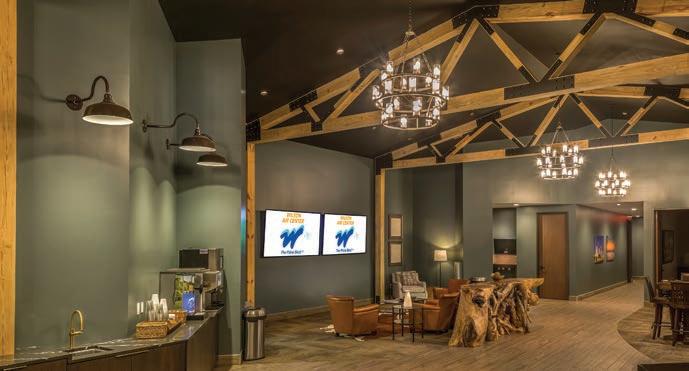
latest ultra-long-range business jets. It is home to 35 turbine-powered aircraft ranging from a pair of Gulfstream G650s down to a Pilatus PC-12 turboprop single.
From its fuel farm, which holds 42,000 gallons of jet-A and 12,000 gallons of avgas, its fleet of tankers (a quartet of 5,000-gallon jet refuelers and a 1,000-gallon 100LL truck handled by the FBO’s NATA Safety 1st trained line technicians) pumps more than 3.5 million gallons a year.
With a sta of 38, the facility is open 24/7 and, according to Garms, claims more than 22% of the business on the field, averaging nearly 1,000 arrivals and departures a month. He noted that the FBO is just entering its peak period of activity, which now lasts from August all the way through the end of May. Most of those customers are Part 91 operators, either corporate flight departments or privately owned aircraft. Houston’s famed MD Anderson Cancer Center also draws many flights, with patients arriving for treatment via aviation charities such as Corporate Angel Network.
Wilson Air is located on the south side of the field, adjacent to the U.S. Customs
facility, where all arriving international private flights must stop on arrival.
Currently, the complex has 465,000 sq ft of ramp space, but that will change when the company kicks off an expansion project in the third quarter, which will add 110,000 sq ft of ramp space along with a new taxiway entrance. With Houston a host city for the FIFA World Cup next year, the goal is to have it ready by the start of the tournament in June.
This month, the company expects to make a go/no-go decision on the development of a 16-acre plot under its control that would be linked to its main ramp by the new 110,000-sq-ft expansion. Plans are under consideration for a further $50 million project consisting of 120,000 sq ft of hangars, offices, and shop space, along with another 400,000 sq ft of ramp.
When it comes to customer service, Garms has no illusions. “There’s nothing hard about customer service, but so many people mess it up,” he explained. “Our employees treat everybody the same way, treat them with respect, and greet them with a smile, and we anticipate their needs as much as we can. Honestly, it’s pretty simple.” C.E.
BY DAVID JACK KENNY
Piper PA-46-350P turbine conversion, May 11, 2025, Greenwood, Indiana
When the pilot attempted to increase power to taxi to the runway, the airplane’s PT6A-35 turboprop engine initially did not respond. It did spool up after he let it run a bit, and the pre-takeoff checks appeared normal, but the engine lost all power shortly after takeoff. Both the pilot and passenger suffered serious injuries when the airplane descended into a taxiway from an altitude of about 100 feet and slid into an embankment, incurring substantial damage to the fuselage.
Cessna S550, May 22, 2025, San Diego, California
The single pilot and all five passengers died when a Citation S550 crashed into a residential neighborhood during an attempted approach to Montgomery-Gibbs Executive Airport (KMYF), and eight people on the ground were injured. The accident occurred at 03:47, well before dawn. Prevailing weather conditions at Marine Corps Air Station Miramar included calm winds with visibility of half a mile and an indefinite ceiling at 200 feet.
The flight from Teterboro, New Jersey, refueled at Colonel James Jabara Airport in Wichita, Kansas, and departed Wichita at 02:36 Central time. Checking in with Southern California Tracon, the pilot acknowledged knowing that KMYF’s ASOS was out of service and requested the RNAV approach to Runway 28R. Weather minimums for that approach include
three-quarters of a mile visibility and ceilings from 250 to 500 feet, depending on whether vertical guidance is provided.
The controller cleared the pilot to the NESTY approach fix at 9,000 feet and provided the weather observation from Miramar. He received his approach clearance five miles from NESTY with instructions to cross at or above 3,800 feet. The jet slowed from 200 to 120 knots on the approach course, crossing the PALOS fix 2.9 miles from the threshold 190 feet below the minimum crossing altitude. The last ADS-B data point showed an altitude of 60 feet. The airplane struck the ground 1.8 miles from Runway 28R’s displaced threshold, hitting one residence and 20 vehicles and sparking a post-crash fire.
A cockpit voice recorder was located in the wreckage. FAR Part 91 does not prohibit attempting an instrument approach in weather conditions below the procedure’s minimums, nor does it require current weather data from the destination airport.
Bell 206B, Jan. 22, 2023, Itacarė, Bahia State, Brazil
The locknuts securing the bolts holding the inner coupling to the engine-side power shaft flange of the main driveshaft assembly loosened in flight, causing a sudden loss of main rotor rpm. While en route at about 90 knots airspeed and an altitude of 1,000 feet, the pilot observed an abrupt 30% reduction in torque accompanied by an uncommanded left yaw, after which the helicopter began to descend. The pilot executed an emergency autorotation, and although their low altitude prevented them from reaching
the intended landing site, both he and his passenger escaped without injury.
Investigators found the boot protecting the transmission’s inner coupling torn on the transmission side. The bolts were bent and showed crush damage to their threads. The bolt holes on the engine side of the flange were elongated, with denting and polishing marks caused by movement of the bolt heads. The excessive play unbalanced the drive shaft; the eventual separation of the inner coupling from the engineside power shaft flange caused the loss of power to the main rotor system. Investigators were unable to determine whether the locknuts had been overtorqued, undertorqued, or reused during overhaul contrary to the manufacturer’s requirements (which in turn could have caused either over- or undertorquing).
Although the engine produced only 338 of its rated 420 horsepower during a postaccident bench run, this was attributed to a combination of impact damage and uneven spray from the fuel nozzle, which would have been expected to cause a gradual rather than a sudden power loss. Investigators also noted that the pilot’s type rating for single-engine turbine helicopters had expired in February 2021, leaving him legally ineligible to act as pilot in command despite having flown the accident aircraft 17.5 hours in the preceding 90 days. This, too, was not believed to have contributed to the accident.
Pilatus PC-12, Feb. 24, 2023, Stagecoach, Nevada
Spatial disorientation following autopilot disengagement led to the in-flight breakup of a Guardian Flight Pilatus PC-12 operating under the Care Flight brand. The pilot,
flight nurse, flight paramedic, and two passengers were killed when the aircraft crashed near Stagecoach, Nevada.
The air ambulance flight, a non-emergency medical transport, departed Reno-Tahoe International Airport (KRNO) at 21:00 under IFR in night instrument meteorological conditions. Cloud bases were reported at 1,200 feet agl with tops near FL240. Cleared to climb to 25,000 feet, the PC-12 never reached its assigned cruising altitude.
About 11 minutes into the flight, the aircraft deviated from its assigned routing and entered a series of altitude and heading changes. Investigators concluded that the flight path was consistent with a graveyard spiral—a type of spatial disorientation where the pilot misperceives a descending turn as level flight and, in attempting to arrest an apparent descent, further tightens the spiral, potentially leading to structural failure.
“The pilot’s loss of control due to spatial disorientation while operating in night instrument meteorological conditions… resulted in an in-flight breakup,” the NTSB found. Contributing factors included “the disengagement of the autopilot for undetermined reasons, as well as the operator’s insufficient flight risk assessment process and lack of organizational oversight.”
The PC-12’s autopilot disengaged twice during the flight. The second event occurred two to four minutes before the crash. The autopilot was not reengaged, requiring manual control in IMC. No anomalies were found with the autopilot, trim servos, or other control systems.
After climbing to about 19,400 feet msl, the aircraft entered a steep descending right turn. Descent rate exceeded 13,000 fpm before radar contact was lost at approximately 11,100 feet msl. The distribution of wreckage and structural damage was consistent with in-flight breakup due to aerodynamic overstress.
The pilot, classified as a float pilot, had been employed for only five months and had limited recent time in type and in
the region. Both medical crew members had less than six months’ tenure with the company.
No risk assessment form was found for the accident flight. The operator’s fixed-wing division lacked the crew pairing protocols required for its rotorcraft operations. Other operators had declined similar missions earlier in the day due to weather, but this was not communicated to the accident crew.
An autopsy revealed a 3-centimeter brain tumor in the pilot’s right parietal lobe, an area linked to sensory and navigational processing. While the NTSB could not determine its effect on performance, it noted that the tumor “may have impacted the pilot’s ability to synthesize and respond to sensory interpretation.”
The aircraft was not equipped with a cockpit voice or flight data recorder. However, onboard systems and GPS data enabled investigators to reconstruct the flight path. No mechanical failure was found that would have prevented normal flight.
HondaJet HA-420, May 18, 2023, Summerville, South Carolina
Improper landing speed and distance calculations by the pilot caused a HondaJet HA-420 to overrun a wet runway at Summerville Airport (KDYB) in South Carolina, according to the NTSB’s final report. The aircraft, registered as N255HJ, was destroyed by fire after sliding down an embankment beyond the end of the runway, but the pilot and five passengers escaped without injury.
The jet departed Wilkes County Airport (KUKF) at 23:29 on an IFR flight and landed at KDYB at approximately 00:14 in night visual meteorological conditions. The pilot, flying under Part 91, told investigators he used the cockpit display unit (CDU) to calculate a landing reference speed (Vref) of 119 to 120 knots and believed the 5,000-foot asphalt runway provided sufficient length for landing.
ADS-B data showed the jet crossing the runway threshold at 120 knots groundspeed and 119 knots calibrated airspeed. However, Honda Aircraft engineers later determined that the appropriate Vref under the accident conditions was closer to 112 knots, with a wet runway landing distance requirement of about 4,829 feet. With those parameters, the CDU would have issued a warning: “LANDING FIELD LENGTH INSUFFICIENT.”
The aircraft touched down before the 1,000-foot runway markers, and the pilot applied full braking. He reported that the antiskid system cycled more slowly than expected and produced minimal braking force. A sudden grab from the left brake caused the aircraft to yaw and skid, prompting the pilot to abandon thoughts of a go-around. The aircraft overran the runway, descended an embankment, and came to rest 360 feet beyond the paved surface on a rocky berm. A post-impact fire consumed the cockpit, right wing, and center fuselage.
Investigators found no mechanical faults with the brake system that could explain the performance discrepancy. Initial bench testing of the power brake and antiskid valve revealed anomalous hysteresis, or delayed response, but certified testing at the manufacturer’s facility showed no irregularities. While such hysteresis “may lead to braking performance degradation,” the NTSB could not confirm a link to the overrun.
At the time of the accident, the operator had not installed Honda’s 2022 update that incorporated revised performance data and advisory functions for wet and contaminated runways. The free software supplement was recommended but not required under Part 91.
The aircraft was not equipped with a cockpit voice or flight data recorder, nor was one required. The investigation relied on ADS-B data and witness accounts to reconstruct the accident sequence. z
Amy Wilder contributed to this report
BY GORDON GILBERT
8, 2025
Under a proposal from the U.S. Environmental Protection Agency, changes would impact the specifications, production levels, availability, and costs of sustainable aviation fuel (SAF) to increase and expand its availability by U.S. providers. “We have also considered the potential for increasing volumes of renewable jet fuel,” the proposal says. “Given its similarity to renewable diesel, for purposes of projecting appropriate volume requirements for 2026 and 2027, in most cases we consider renewable jet fuel to be a component of renewable diesel.” However, U.S. SAF producers would be under additional pressure to meet proposed availability levels because the new rules’ main goal is to “reduce the input of fuels and feedstocks from foreign countries.” Further, the requirements would eliminate the electric vehicle mandate by removing electricity as qualifying under the renewable fuel standard. Comments on the proposal are due by Aug. 8, 2025.
Sept. 1, 2025
Hong Kong has delayed the scheduled startup of its Advance Passenger Information System (APIS) program. Originally set to become e ff ective on April 1, 2025, the revised implementation date is Sept. 1, 2025. These changes are part of a broader e ff ort to enhance aviation security through the electronic transmission of passenger and crew data to border control authorities before a flight’s arrival. The APIS requirements will apply to all flights arriving in Hong Kong, including those operated by commercial, business, and general aviation. Specifically for business aviation, this means that operators of private and charter flights arriving in Hong Kong will be required to submit APIS data for all passengers and crew members before the aircraft’s arrival. Flights departing from Hong Kong are not affected by this requirement.
Sept. 16, 2025
The European Commission has launched a call for high-priority applied research to help shape the future regulatory framework of its planned Digital European Sky ATC
management network. The request identifies research topics defined by EASA and an EU member state advisory board. Research themes sought include human operator role versus automation, including artificial intelligence and machine learning; single European sky airspace classifications; certification of novel air traffic management systems; methods for evaluating ATC and air navigation services; and ground equipment safety. Research proposals for the project are due by Sept. 16, 2025.
Oct. 10, 2025
U.S.-based repair stations must comply with the current version of the FAA/EASA Maintenance Annex Guide to obtain EASA Part 145 approval. The latest revision of the guide requires that, effective Oct. 10, 2025, U.S.based repair facilities implement an FAA-approved safety management system (SMS). The SMS must be integrated into the repair station’s procedures and processes, support the Guide’s special conditions and, as a minimum, include the requirements outlined in the FAA SMS voluntary program. To receive initial or continuous approval, the SMS application to EASA must show that it is appropriate for “the size, scope, and complexity of the repair station’s operations.”
Oct. 27, 2025
Regulators of Gatwick Airport continue to make progress with its plans for capacity expansion, one component of Gatwick Airport Limited’s future investment program between 2025 and 2029. A key proposal is to extend its current “standby” northern runway and bring it into regular use, which could increase the airport’s maximum capacity by an estimated 13 million passengers per year. The U.K.’s Secretary of State has issued a “minded to approve” decision on Gatwick’s northern runway project, and the deadline for the final decision is Oct. 27, 2025. Other elements of the program include a price cap on operator fees that aims to ensure reductions in airport charges.
Oct. 31, 2025
During October 2025, the FAA is scheduled to transition its notam format to align with international standards, nearly a year later than originally targeted. The agency said the transition to the new format will ensure U.S. notams are compliant with standards set by the International Civil Aviation Organization (ICAO). According to the FAA, the new format will result in improved accuracy and accessibility of notam information for pilots, dispatchers,



BY JESSICA REED

CAE selected Matthew Bromberg as its next president and CEO, effective August 13. Bromberg brings extensive aerospace and defense experience to the role, having overseen major operational transformations at some of the industry’s largest companies, including Northrop Grumman, RTX (formerly Raytheon Technologies), and Pratt & Whitney. The transition follows the previously announced departure of Marc Parent, who served as CAE’s president and CEO for 16 years.
Redbird Flight named Charlie Gregoire, previously COO, as its new CEO. Josh Harnagel, v-p of customer experience, was selected as the company’s COO.
Marc Ricks joined Avports as CEO, having most recently served as CEO of ShopCore Properties. Ricks’ 20-plus years of related experience include working at Vornado Realty Trust and for the New York City mayor’s office. He took over from Jorge Roberts, who served as CEO of Avports for more than six years.

Airshare hired Suzanne Williams as COO and also appointed her to its board of directors. Williams served as CFO at advertising agency BarkleyOKRP for the past decade and previously held a number of positions in finance at Sprint.
Steve Drzymalla was named CCO of Titan Aviation Fuels. Drzymalla’s more than two decades of experience in the aviation industry include leadership roles in business development and commercial operations.
XTI Aerospace hired Alex Williams as senior advisor for R&D strategy, advanced manufacturing, and technology integration. His prior experience includes working at Pratt & Whitney, where he supported NASA and U.S. Air Force initiatives, and managing research facilities and programs at Apple.
Devin Osting was named executive director of the Alliance for Aviation Across America . He previously served as interim executive director, succeeding long-time leader Selena Shilad, who
passed away. Three new members also joined the board of directors: Lindsey Daugherty, a Colorado state senator and communications director at Bye Aerospace; Michael Inman , mayor of Macomb, Illinois; and Bryan Budds, Michigan Department of Transportation’s aeronautics director.
New leadership was selected for NATA’s board of directors and two new board members were elected. Cristine Kirk, CEO of Malone AirCharter, will serve a two-year term as chair of the NATA board. Geoff Heck, president and COO of Aero Centers, will serve as vice chair. COO of Sheltair Aviation Todd Anderson will continue to serve as immediate past chair on the association’s executive committee.
Randy Jones joined Nighthawk Flight Systems as v-p of sales and marketing. His 30-plus years of experience in aerospace and defense sales, marketing, and business development include an executive role at a manufacturing organization.

TAG Aviation’s Angel Wun successfully completed her line check, earning the status of Gulfstream G650 junior first officer via the TAG Trained Pilot program. Wun joined the company as a safety officer in 2018 and has also received the Sir Donald Anderson Award.
Clay Lacy Aviation appointed Barbara Brown as its new chief people officer. Brown’s 25-plus years of prior experience in human resources include senior leadership roles at the University of Southern California.

Jeff Moneypenny joined Le Bas International as director of commercial jets. His career in aviation spans 24 years, including 21 years as v-p of sales at Ultimate Jet Charter.
Jet Support Services Inc. (JSSI) named Philipe Figueiredo v-p of business development for JSSI Parts & Leasing. Figueiredo recently served as managing director at Brazilian private aircraft importer Razac and previously oversaw sales efforts for Honeywell International and Lider Táxi Aéreo in Latin America.
Canadian Advanced Air Mobility named Simar Miglani and Niloofar Moradi as its newest board members. Miglani is the business development and strategy lead for CAE’s advanced air mobility and air traffic services training business. Moradi is director of strategy and business development at the National Research Council of Canada’s Aerospace Research Centre.
Vertical Aerospace appointed Andrew Parker to its board of directors on June 2. Parker served as director general of the UK government’s national security agency, MI5, from 2013 to 2020.
Aircraft Specialties hired Justin Miller as director of business development and regional sales manager for the West Coast. Miller was hired as warehouse manager at Boeing/Aviall in 2006 and eventually became sales director there; more recently, he served as v-p of business development at Seattle Aviation Solutions.

Jade Hayes joined the National Aviation Hall of Fame as its new communications and membership manager. Hayes, a public affairs communications professional, is an MPA candidate at the University of North Carolina at Chapel Hill.
Phenix Jet Cayman hired Philipp Kugelmann as v-p of sales and business development for Southeast Asia. Kugelmann’s 18-plus years of aircraft sales leadership experience in Asia-Pacific includes a term as Bombardier sales director for northern Asia.
Duncan Aviation promoted Dennis Kruse to regional satellite avionics sales rep, supporting the company’s locations in Scottsdale, Arizona; Denver; Las Vegas; Van Nuys and Sacramento, California; Seattle; and Portland, Oregon.
Brittany Churchill was named Heart Aerospace’s v-p of operations and is now a member of the executive leadership team. Churchill previously worked at ABL Space Systems (now Long Wall) and SpaceX. Heart also promoted Cole Randle, formerly head of strategic engagement, to chief of staff and head of corporate affairs. Randle, now a member of the executive leadership team, started his career at the White House during the Obama administration. z
William Langewiesche, the acclaimed aviation writer and professional pilot who brought unprecedented literary depth to aircraft accident investigations and industry analysis, passed away on June 15 in Connecticut. He was 70. Langewiesche was a unique figure in aviation journalism—a professional pilot who wrote for major publications including The Atlantic, Vanity Fair, and The New York Times Magazine for nearly three decades.
Frederick Smith—founder and former CEO of FedEx and a champion of business aviation throughout his career— passed away on June 21. Smith established FedEx in the early 1970s, initially operating with Dassault Falcon 20 business jets before building a pioneering dedicated cargo airline and eventually what became the world’s largest fleet of Cessna Caravan turboprop singles.
Joseph Carroll, v-p of JetBrokers, passed away on June 4 surrounded by family. He attended flight school in Vero Beach, Florida, and earned his pilot’s license. He later embarked on a career selling business, turboprop, and jet aircraft.
Robert Suarez, aircraft sales and acquisitions sales rep for Duncan Aviation since early 2023, was recognized by the International Aircraft Dealers Association as a certified aircraft sales broker.
Pete Bunce, former GAMA president and CEO, and the entire GAMA team have received the National Aviation Hall of Fame’s 2025 Milton Cani Spirit of Flight Award. During Bunce’s tenure, the association promoted the societal benefits of general aviation while advocating for safety, workforce development, and innovation.
The Air Line Pilots Association presented Sen. Tammy Duckworth (D-Illinois) with its highest legislative recognition, the Pilot Partisan of the Year award, during the organization’s annual Legislative Summit in Washington, D.C., in June. This award acknowledges Duckworth’s advocacy for aviation safety legislation and her support of pilot interests through her role as chair and ranking member on the Commerce, Science, and Transportation Committee’s subcommittee on aviation, space, and innovation.
On Feb. 10, 2025, a parked Gulfstream G200 was struck by a U.S.-registered Learjet 35A that veered off the runway while landing. The Learjet pilot was killed. Another fatal N-numbered business jet accident occurred on March 13, 2025, when a Cessna Citation CJ2 on a planned ferry flight made a right turn and climbed to about 950 feet after takeoff before it began a rapid descent into the ground. The sole pilot aboard died. On May 22, a Citation S550 was destroyed when it crashed on an approach near San Diego. The pilot and five passengers were killed. All three of these accidents occurred under Part 91.
Four accidents of non-U.S.-registered business jets took the lives of 15 individuals in the first half of 2025, compared with a single crash that was fatal to two people in the same period of 2024. On Jan. 9, 2025, a privately operated, Brazilian-registered CitationJet CJ1+ overshot the runway on landing, broke up, and caught fire, resulting in the loss of the pilot’s life. On January 29, a Venezuelan government-operated Citation S/II crashed shortly after takeoff. All three occupants perished.
Two pilots and four passengers died on Jan. 31, 2025, when a chartered Mexicoregistered Learjet 55 air ambulance crashed shortly after takeoff from a U.S. airport on a planned flight home. In addition to the six fatalities on the twinjet, one person on the ground was killed. On June 3, 2025, another Venezuela-registered business jet, a Citation I, crashed in the mountains after taking off from Caracas. All five aboard the private flight lost their lives.
Five fatal accidents of U.S.-registered business turboprops resulted in 18 deaths in the first half of 2025, compared with seven deaths in four accidents in the first half of 2024. Half of the 40 fatalities from six accidents involving non-N-numbered business turboprops included the 20 who died when their chartered Ugandan-registered Beech 1900D crashed in South Sudan. z

JAMES HOLAHAN (1921-2015), FOUNDING EDITOR, WILSON S. LEACH, FOUNDER & CHAIR EMERITUS
EDITOR-IN-CHIEF – Matt Thurber
MANAGING EDITOR – Charles Alcock
DIGITAL EDITOR – Chad Trautvetter
EDITOR AIN MONTHLY MAGAZINE – Kerry Lynch
BUSINESS AVIATION SERVICES EDITOR – Curt Epstein
SENIOR EDITOR – Hanneke Weitering – Technology Editor
COPY EDITOR – Jessica Reed
NEWS REPORTERS – Sarah Rose, Amy Wilder
CONTRIBUTORS – Cathy Buyck – Europe, David Donald – U.K., Mark Huber – Rotorcraft, Jennifer Leach English, David Jack Kenny – Safety, Gordon Gilbert , Jennifer Meszaros – Southeast Asia, Dale Smith, Richard Pedicini, James Wynbrandt
PRODUCTION MANAGER – Martha Jercinovich
GRAPHIC DESIGNER – Grzegorz Rzekos
DIRECTOR OF VIDEO – Ian Whelan
SENIOR DEVELOPER – Cameron MacPherson
FRONT END DEVELOPER – David Lohmeyer
EXECUTIVE CHAIR – Dave Leach
PRESIDENT – Ruben Kempeneer
HEAD OF PEOPLE & BRAND – Jennifer Leach English
SENIOR DIRECTOR, INDUSTRY AFFAIRS AND EVENTS – Nancy O’Brien
ADVERTISING SALES
DIRECTOR OF SALES - Henry Specht
Victoria Tod – Northeastern U.S./Eastern Canada/United Kingdom, +1 (203) 733-4184
Michelle James – Western U.S./Western Canada, +1 (520) 343-0236
Joe Rosone – Midwestern U.S., Southeastern U.S./Caribbean/Brazil, +1 (301) 693-4687
Diana Scogna – Europe/Middle East, +33 6 62 52 25 47
DIRECTOR OF MARKETING AND CLIENT SERVICES – Lisa Valladares
AUDIENCE DEVELOPMENT DIRECTOR – Eileen Silberfeld
EVENTS SPECIALIST – Brien O’Brien
MARKETING SPECIALIST – Alyssa Barry
SOCIAL MEDIA MARKETING – Zach O’Brien
SALES ADMINISTRATOR – Cindy Nesline
MANAGER OF FINANCE & HUMAN RESOURCES – Tracy Britton
ACCOUNTS PAYABLE – Mary Avella
ACCOUNTS RECEIVABLE – Bobbie Bing
U.S. HEADQUARTERS
214 Franklin Ave., Midland Park, NJ 07432, +1 (201) 444-5075
Advertising Inquiries: +1 (201) 345-0085, adsales@ainonline.com
Circulation Inquiries: +1 (201) 345-0085, subscriptions@ainonline.com
WASHINGTON, D.C. EDITORIAL OFFICE: Kerry Lynch: klynch@ainonline.com, Tel: +1 (703) 969-9195
EUROPEAN EDITORIAL OFFICE: Charles Alcock: calcock@ainonline.com, Tel: +44 7799 907595
Aviation International News (ISSN 0887-9877) is published twelve times per year (monthly). Periodicals postage paid at Midland Park, N.J., and additional mailing o ces. Postmaster: Send address changes to AIN Media Group, 214 Franklin Ave., Midland Park, NJ 07432. Allow at least eight weeks for processing. Include old address as well as new, and an address label from a recent issue if possible. Subscription inquiries: +1 (201) 345-0085 or email: subscriptions@ainonline.com.
Aviation International News is a publication of AIN Media Group, 214 Franklin Ave., Midland Park, NJ 07432; Tel.: +1 (201) 444-5075. Copyright © 2025 All rights reserved. Reproduction in whole or in part without permission of AIN Media Group is strictly prohibited. AIN Media Group publishes Aviation International News, AINalerts, AINonline, Business Jet Traveler, BJTwaypoints, ABACE Convention News, Dubai Airshow News, EBACE Convention News, Farnborough Airshow News, FutureFlight.aero, VAI Convention News, LABACE Convention News, MEBAA Convention News, NBAA Convention News, Paris Airshow News, Singapore Airshow News, Mobile Apps: Aviation International News; AINonline. PUBLICATION MAIL AGREEMENT NO. 40649046 RETURN UNDELIVERABLE CANADIAN ADDRESSES TO: PITNEY BOWES INTERNATIONAL MAIL, STATION A, P.O. BOX 54, WINDSOR, ON, N9A 6J5, returns il@imex.pb.com.
For feedback, letters to the editor, or other editorial needs, please contact AIN’s Editors at ainedit@ainonline.com
Save time and money by monitoring the value of your aircraft in 'real-time'.
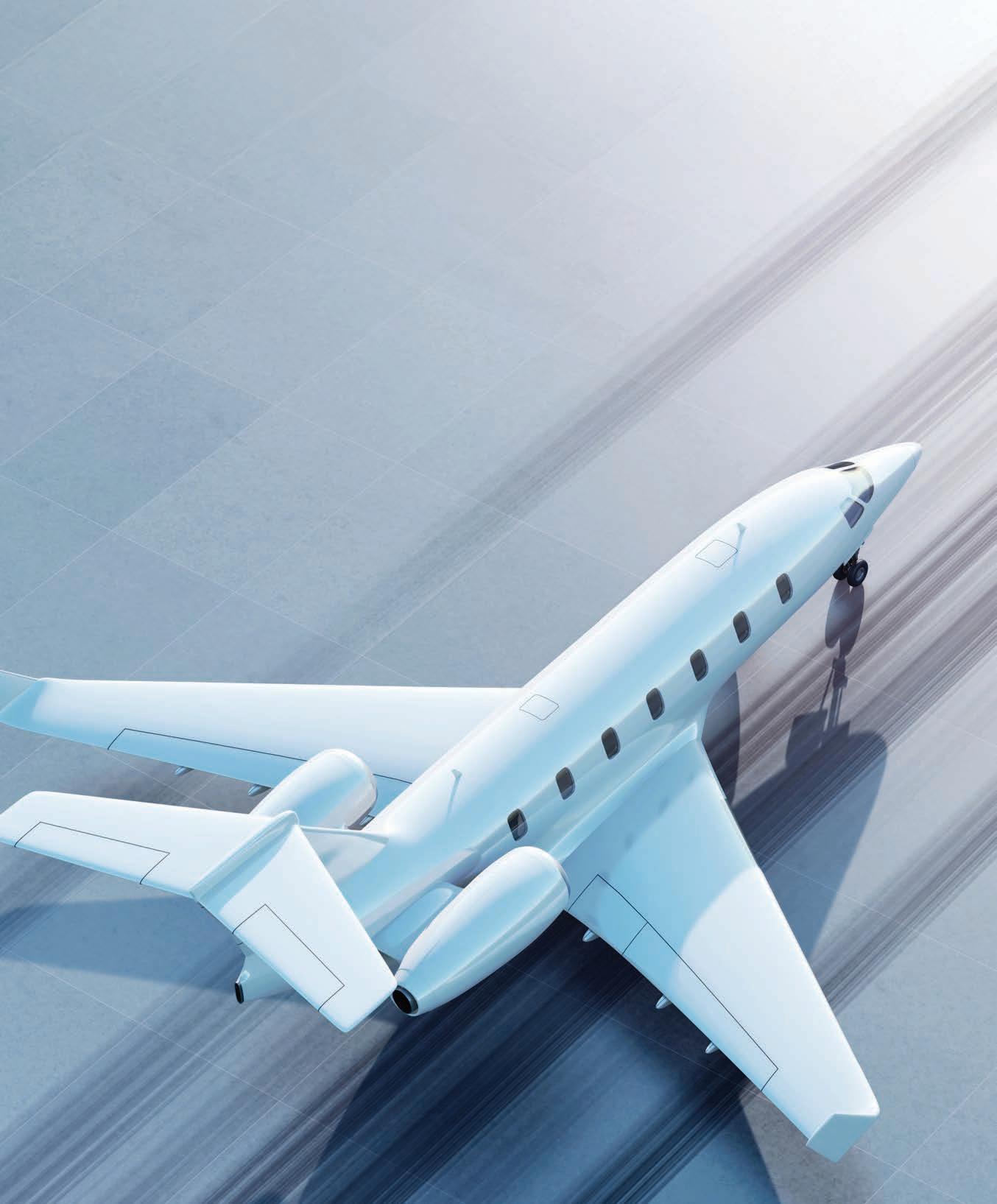
Subscribers can also:
– Generate a comprehensive list of all aircraft transactions in the last 12 months
– View a detailed photo gallery for your specific aircraft
– Receive a weekly report summarizing market fluctuations


Electri cation. Advanced, secure networking. Next generation materials. Hypersonic ight. Arti cial intelligence and machine learning. High-energy lasers. Autonomous, smart sensors. Sixth generation engine technologies. These are just some of the ways we’re transforming how we connect and protect our world. Finding answers to the biggest questions is what de nes us.
Learn more at rtx.com